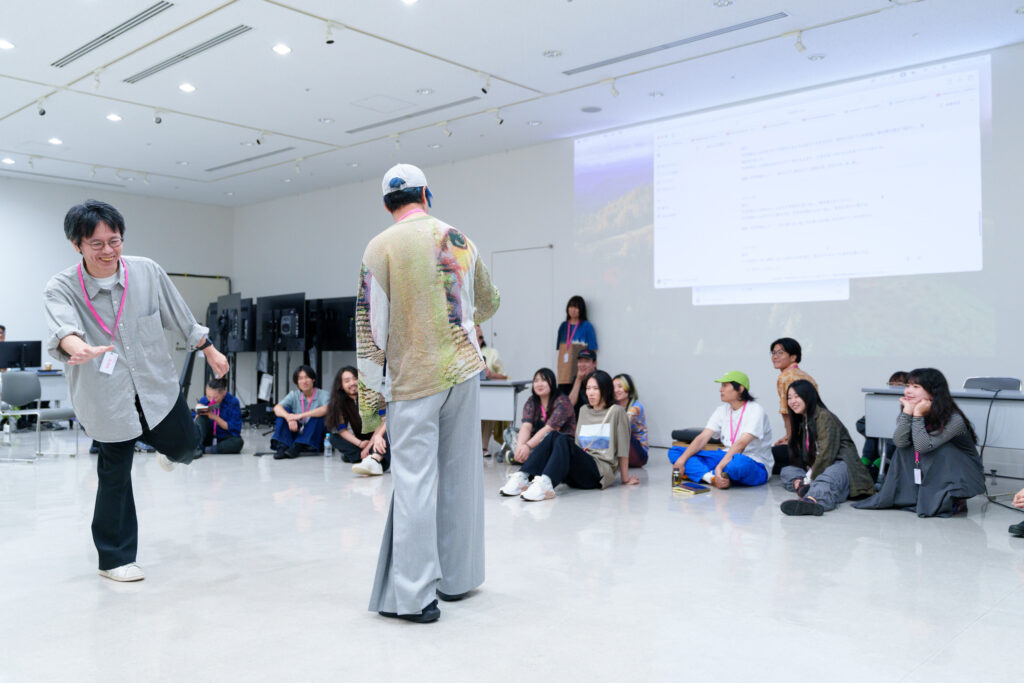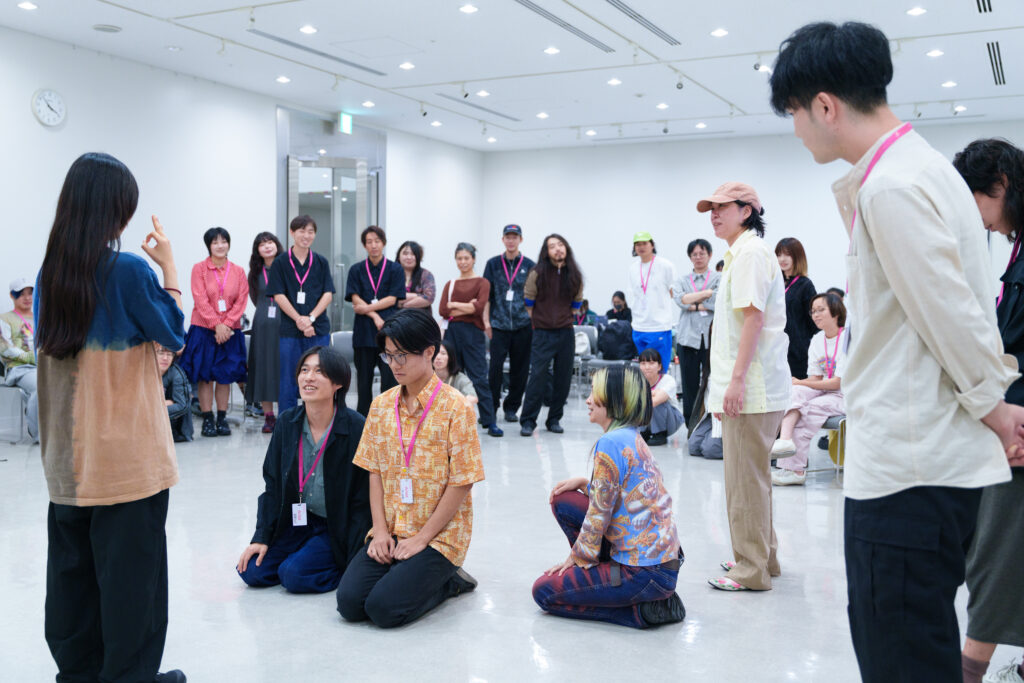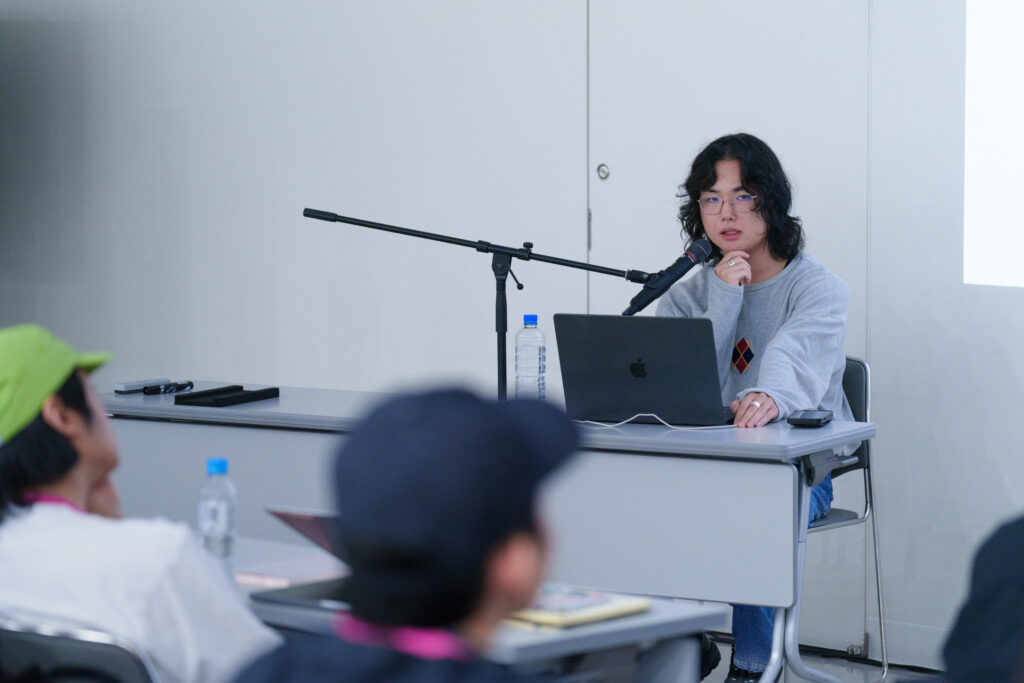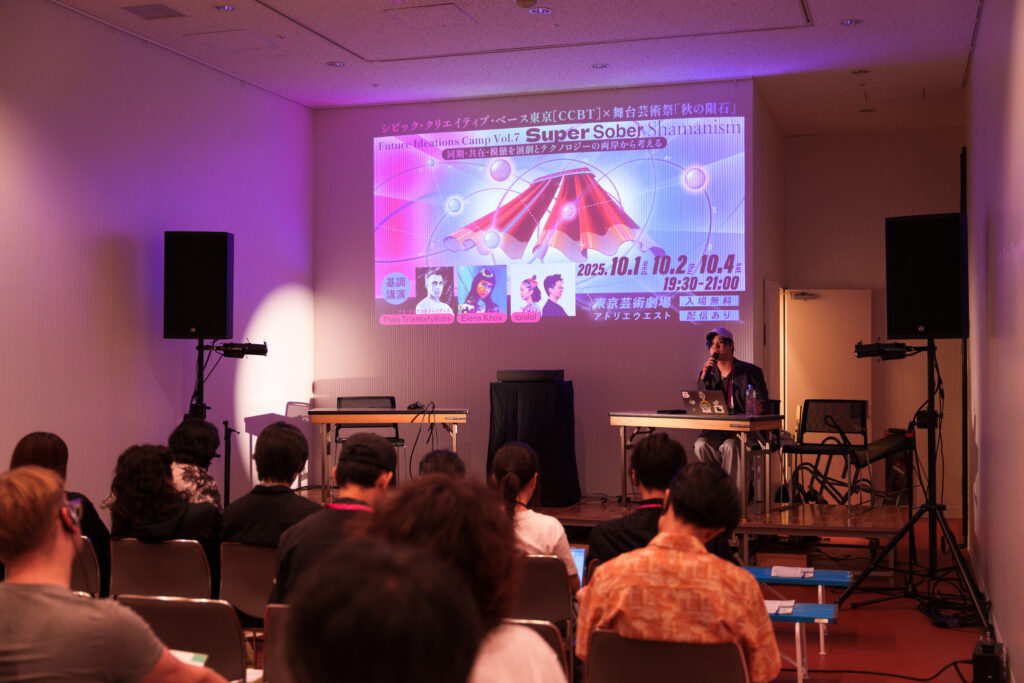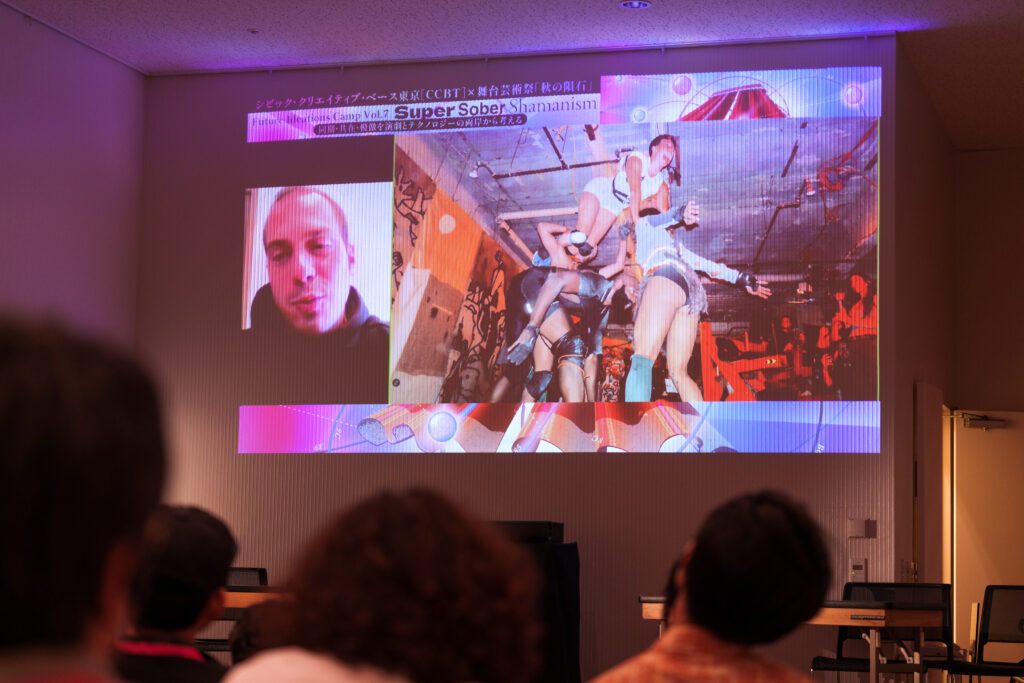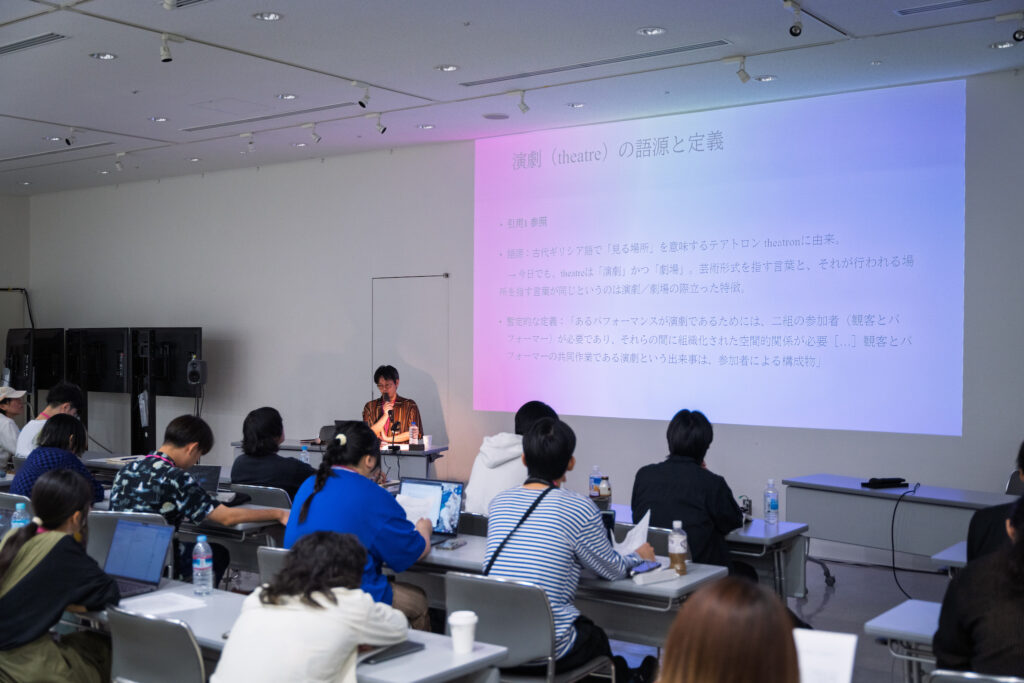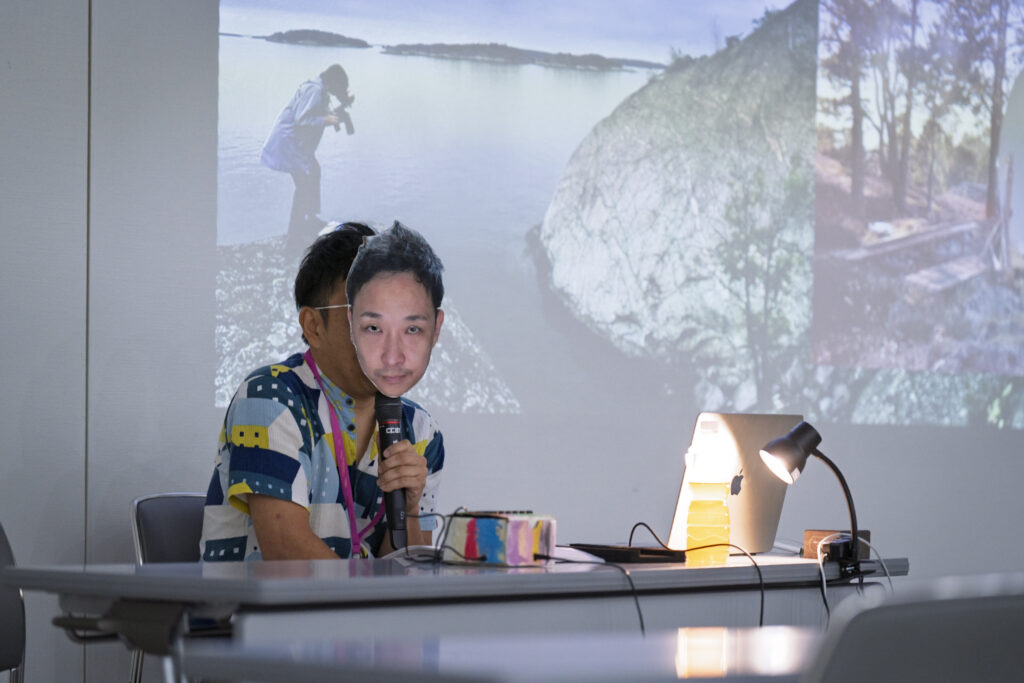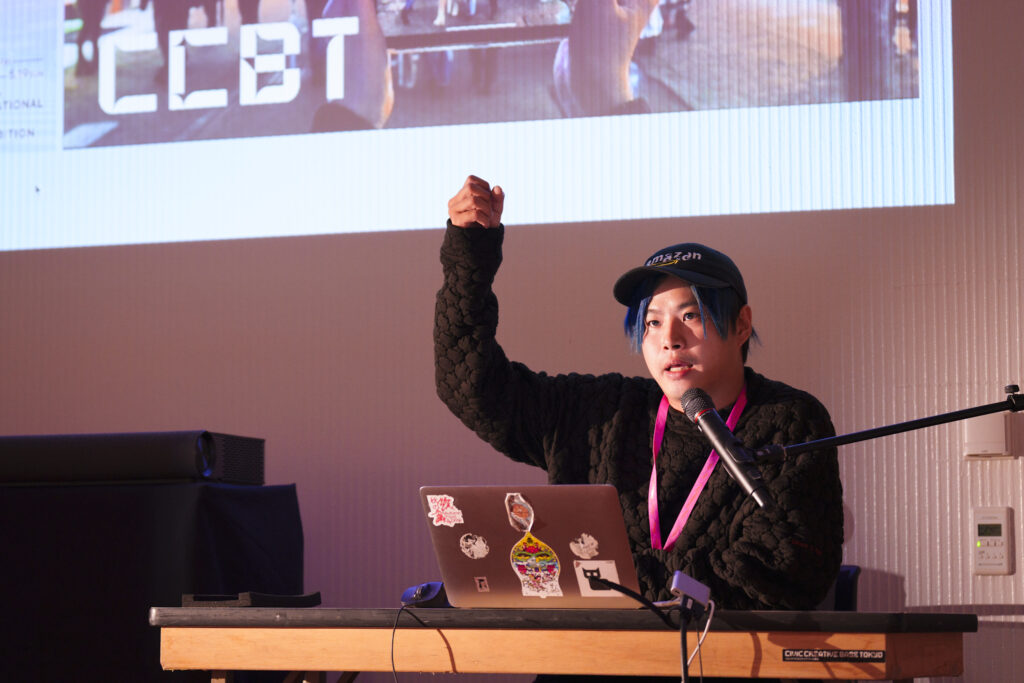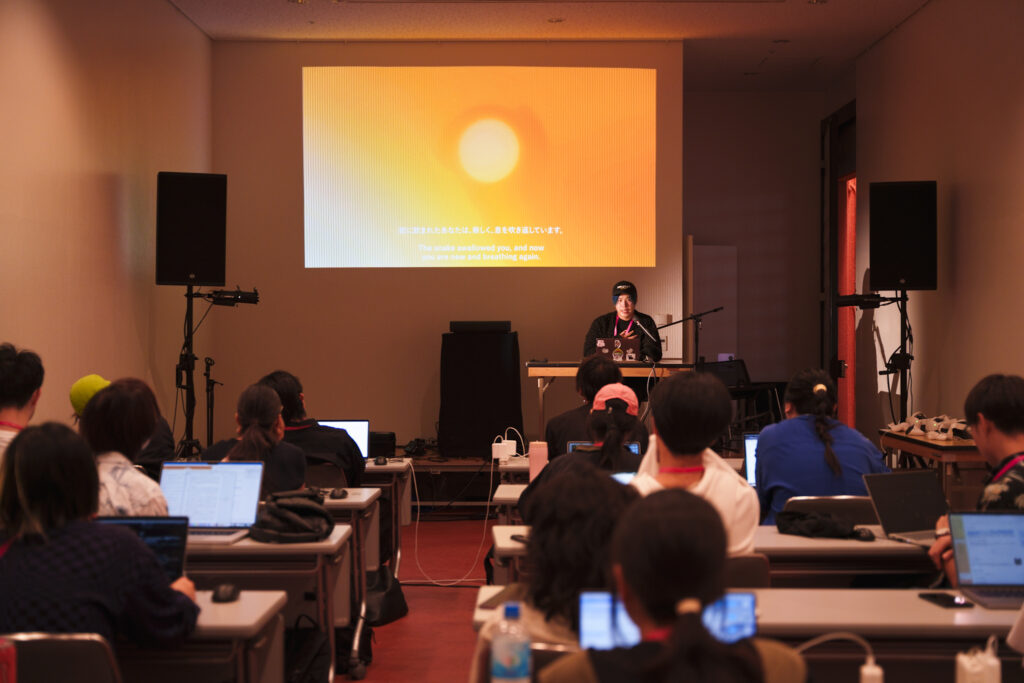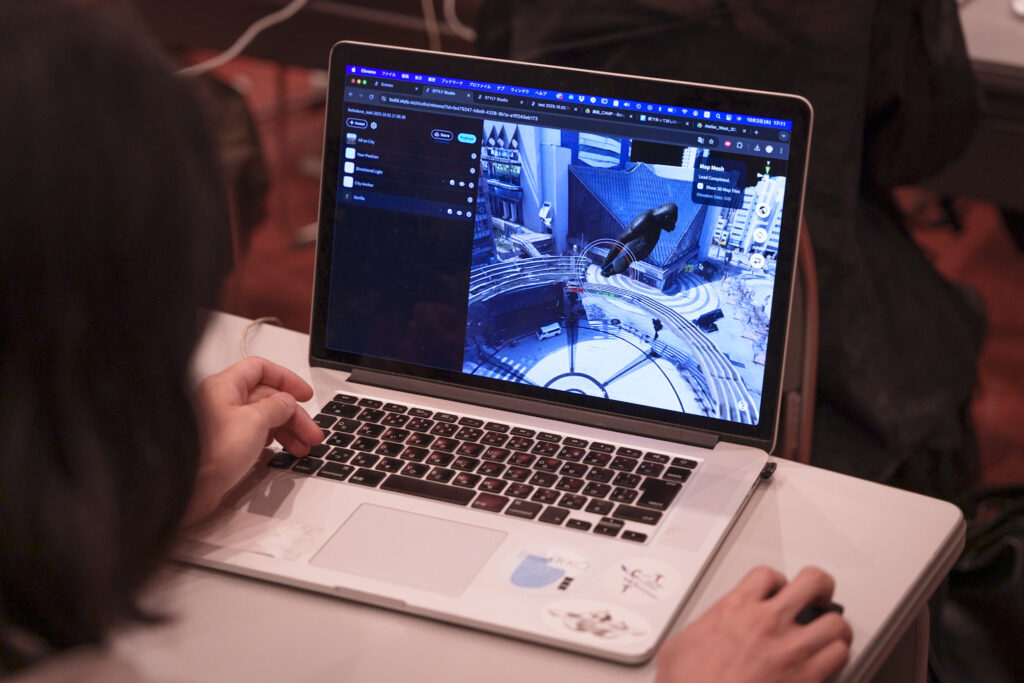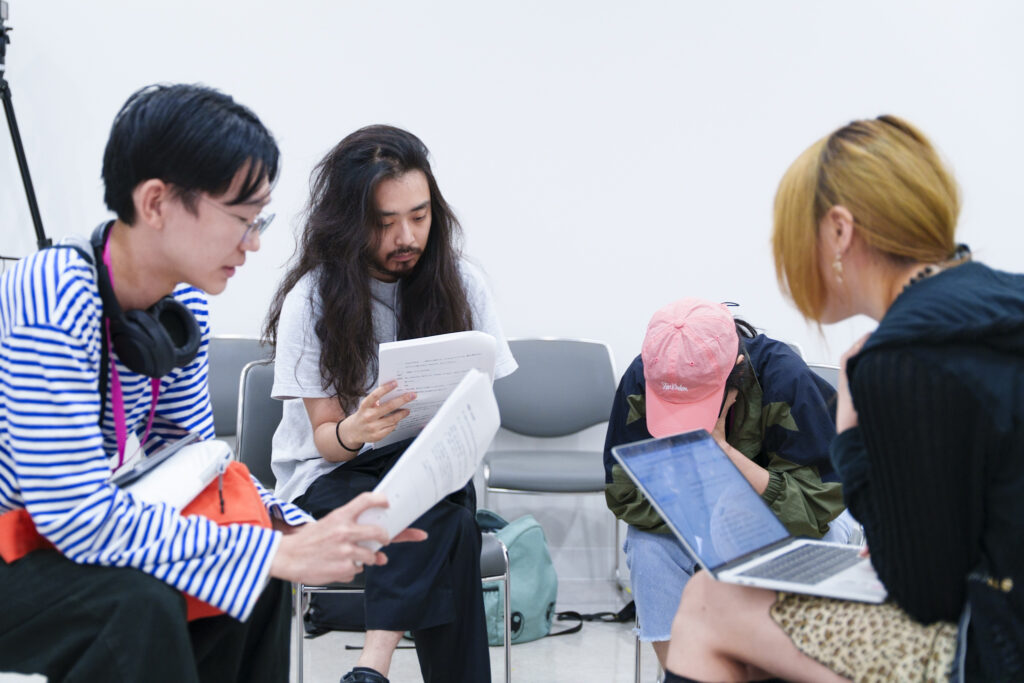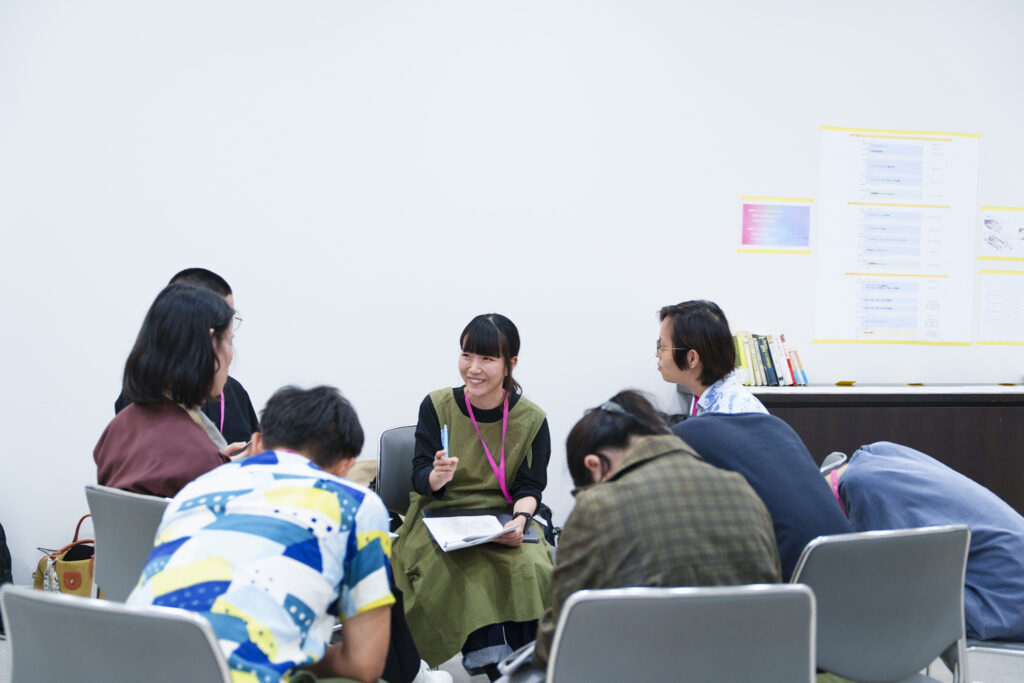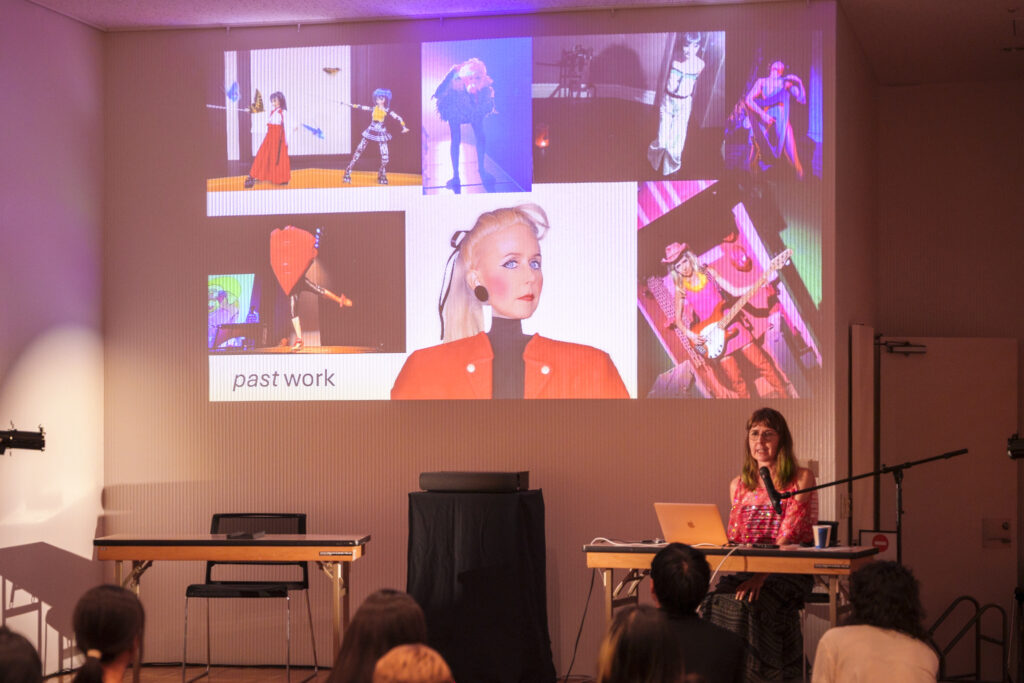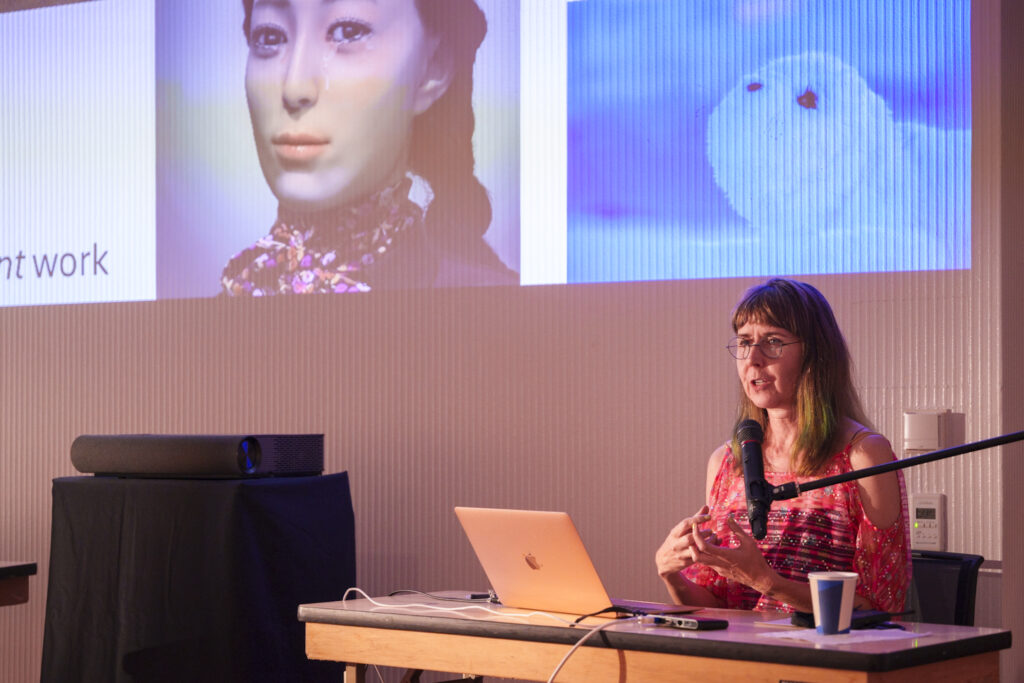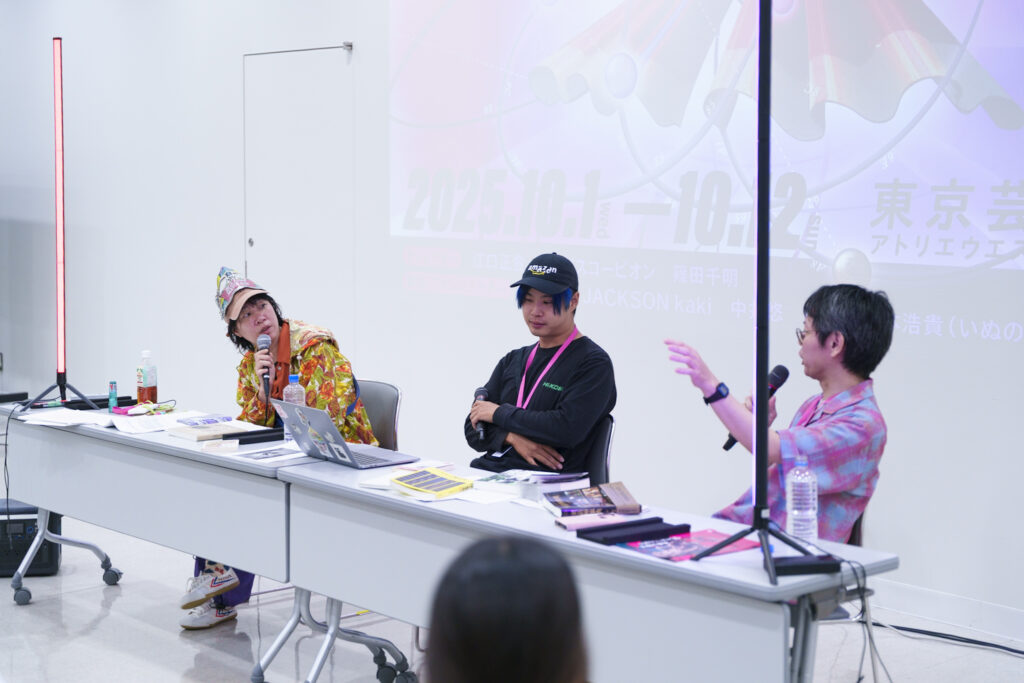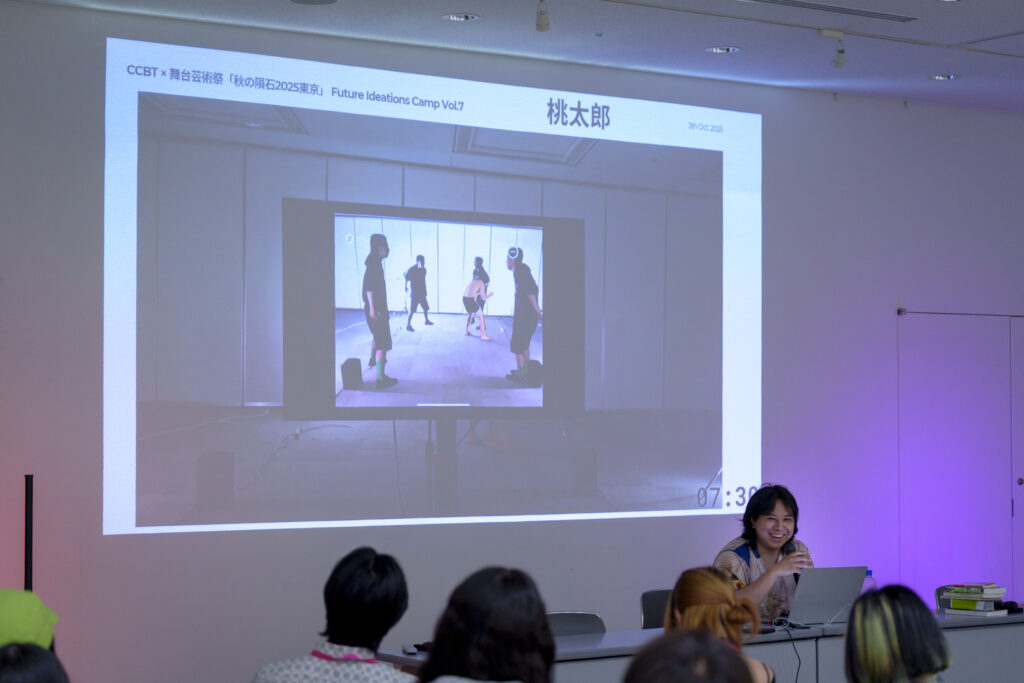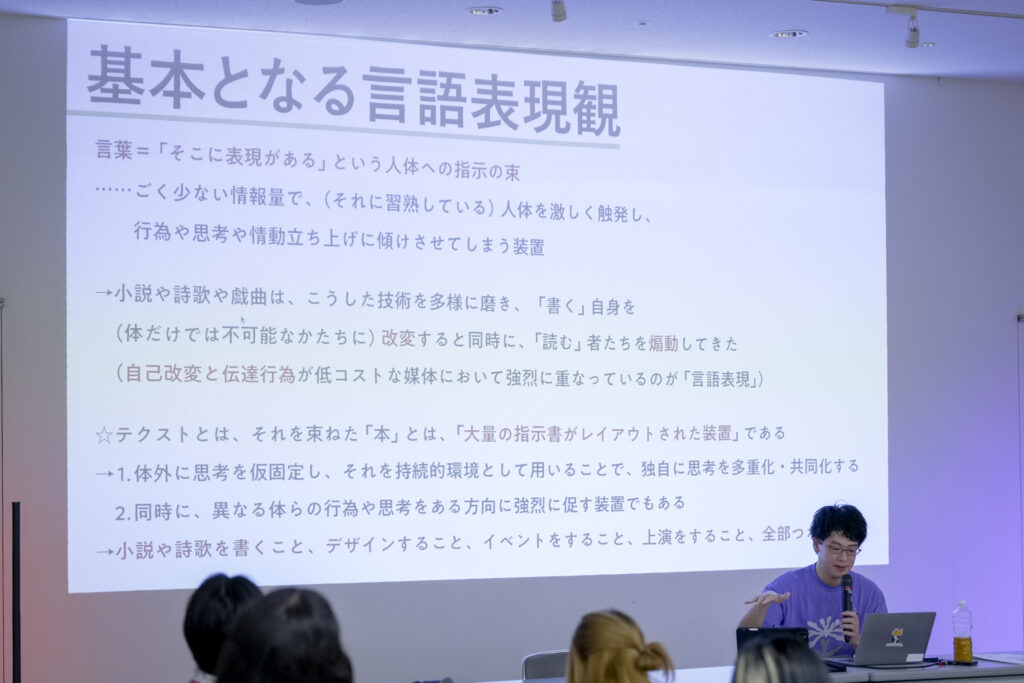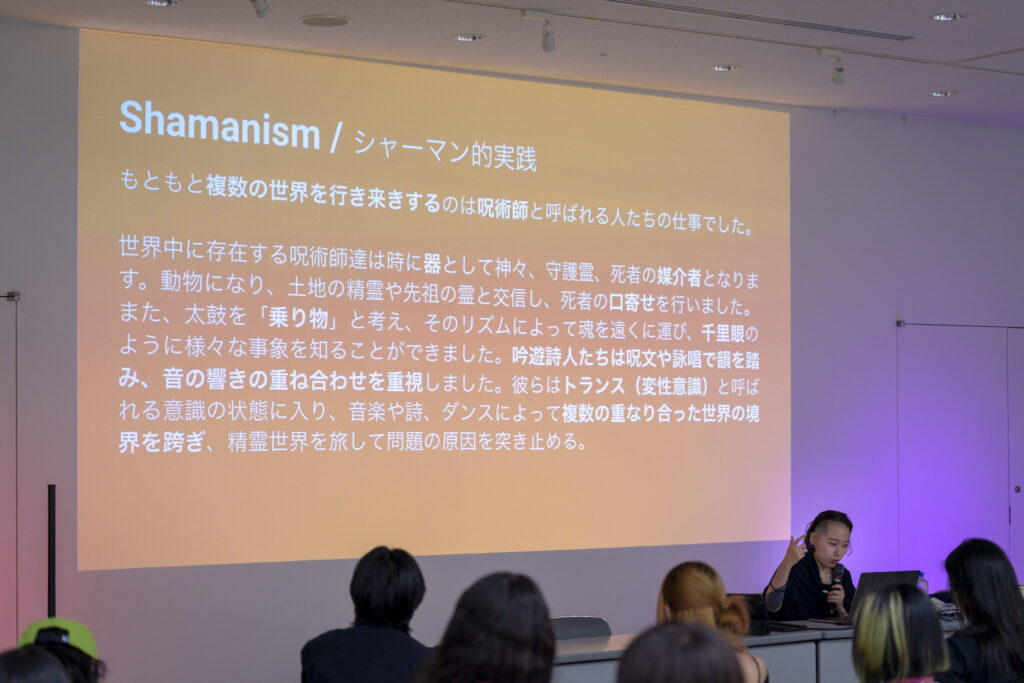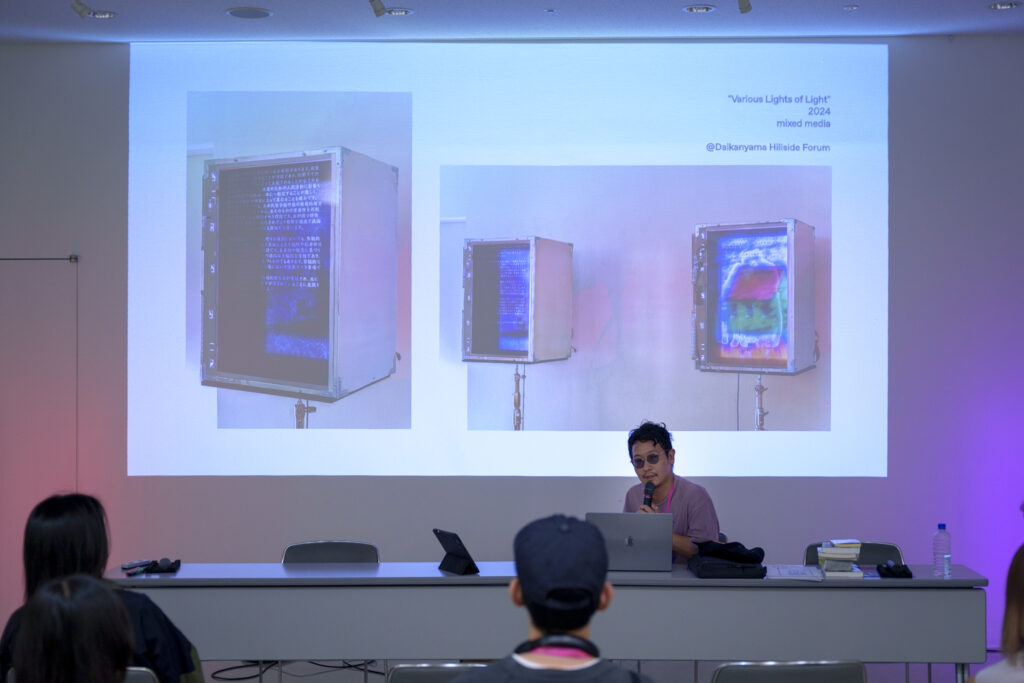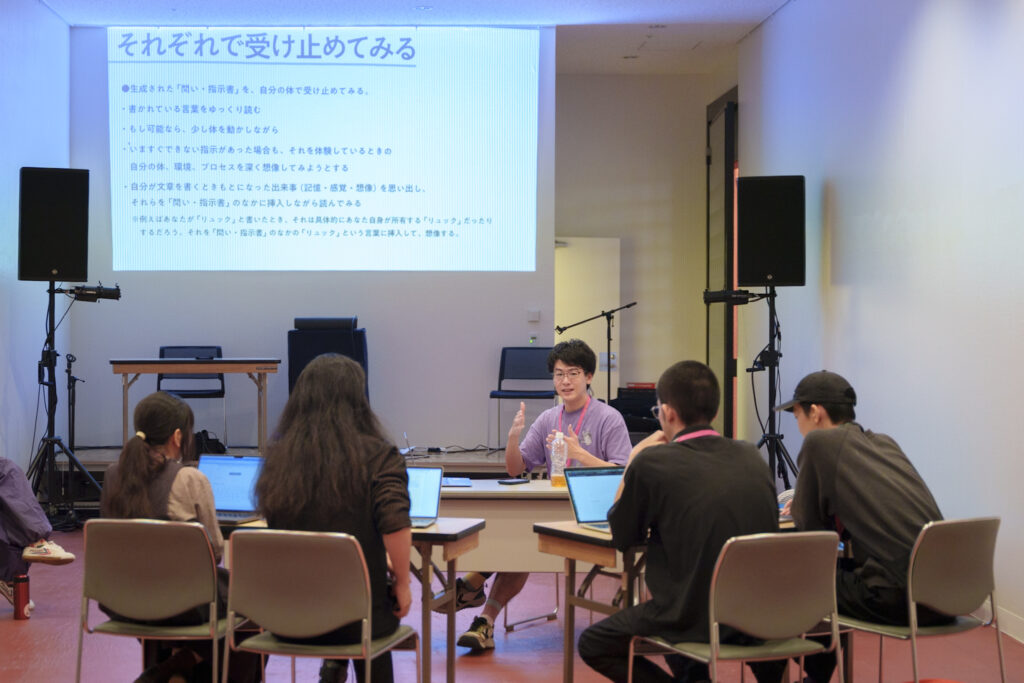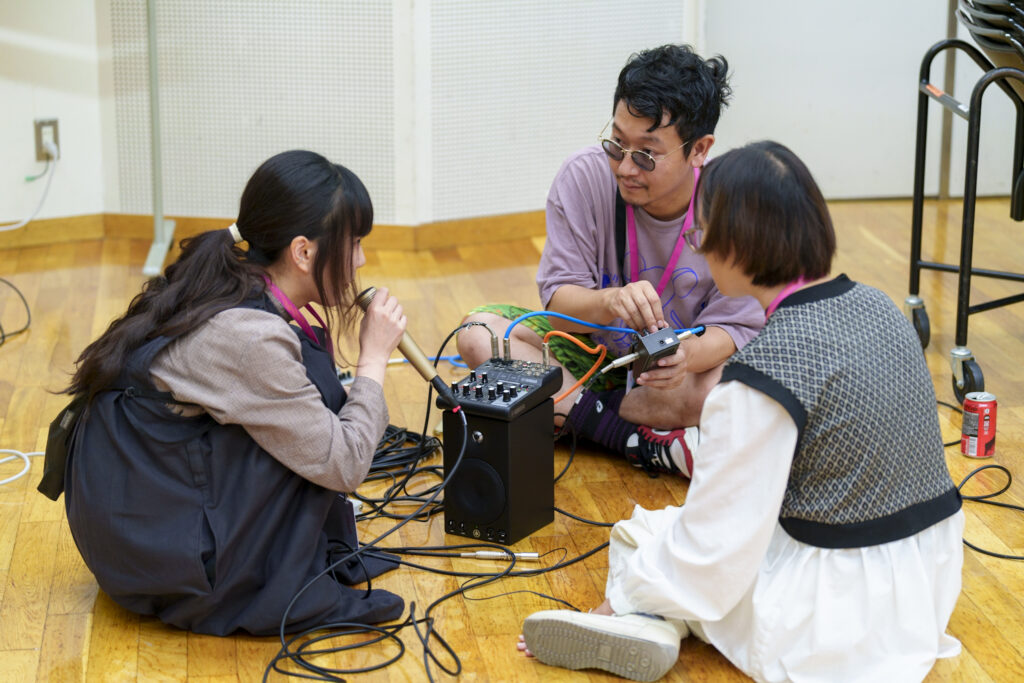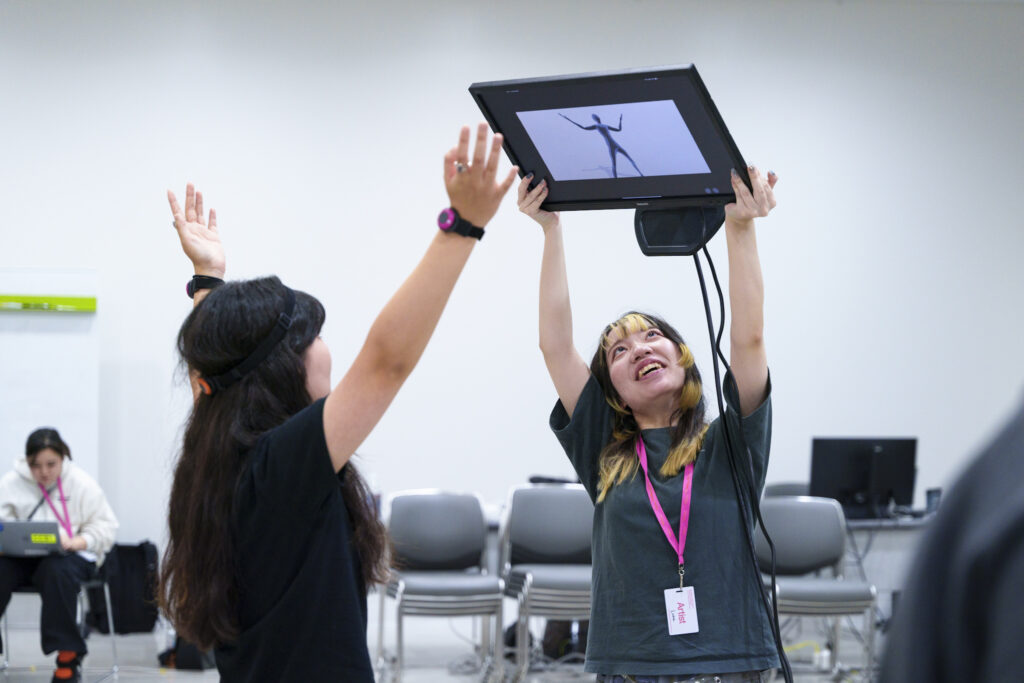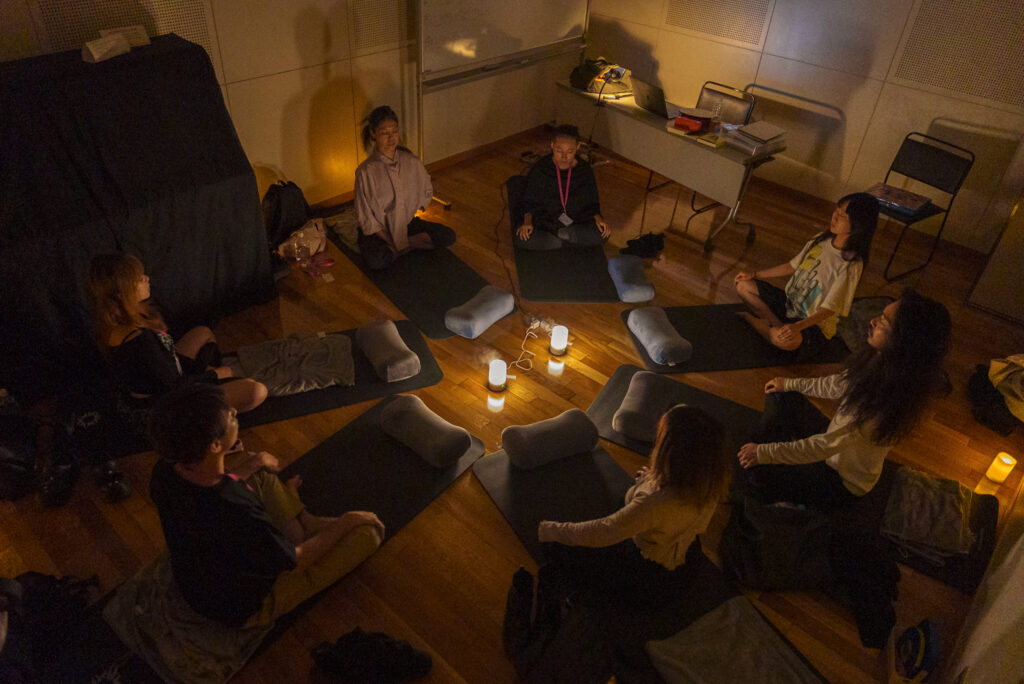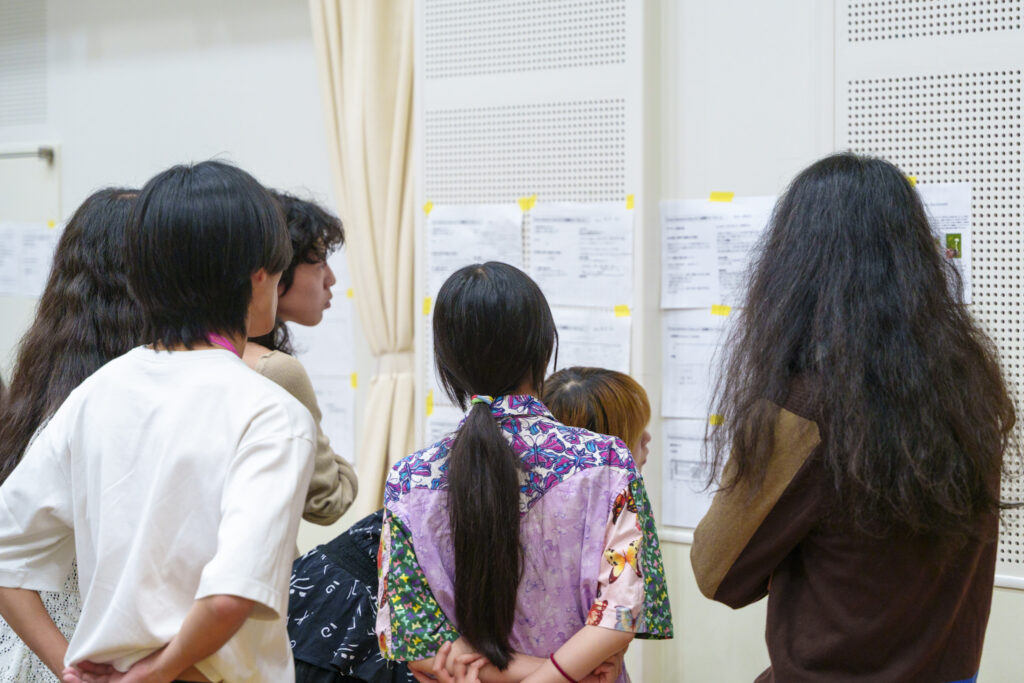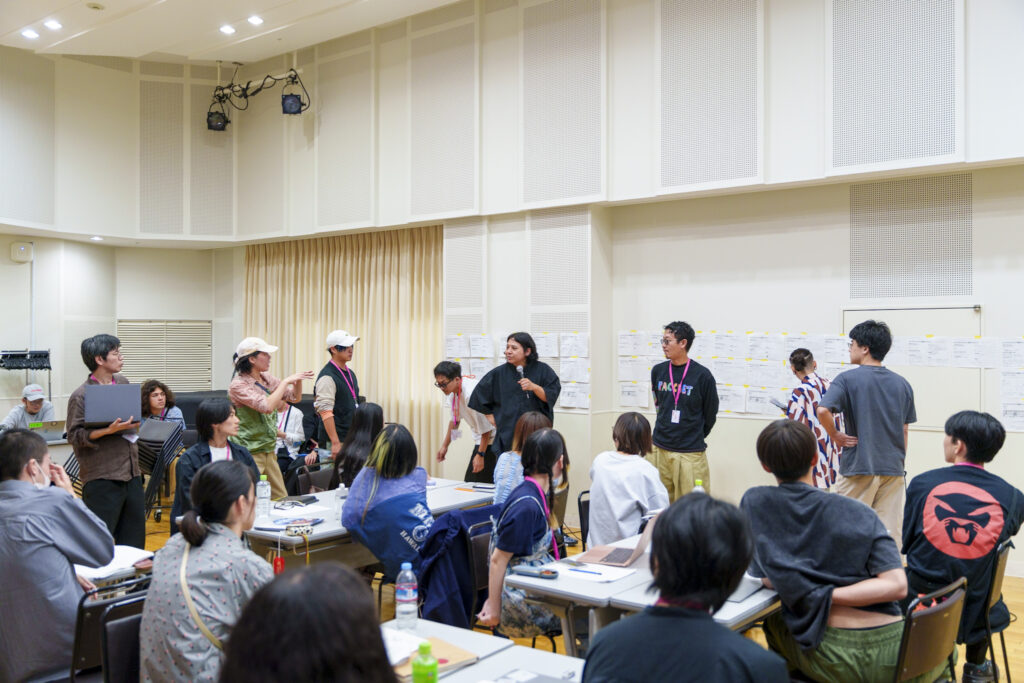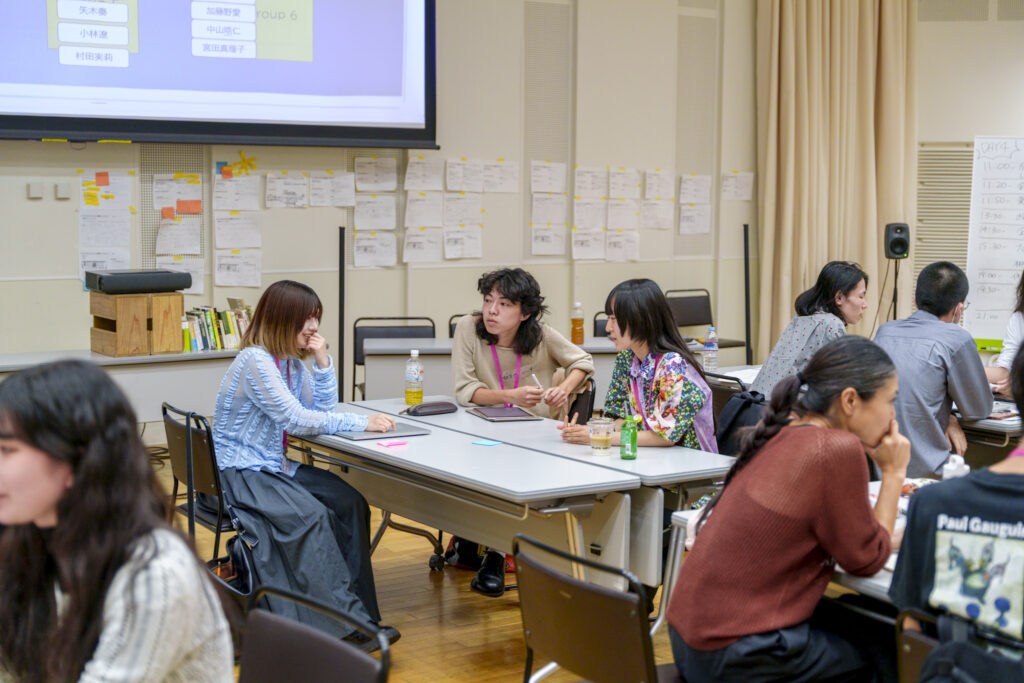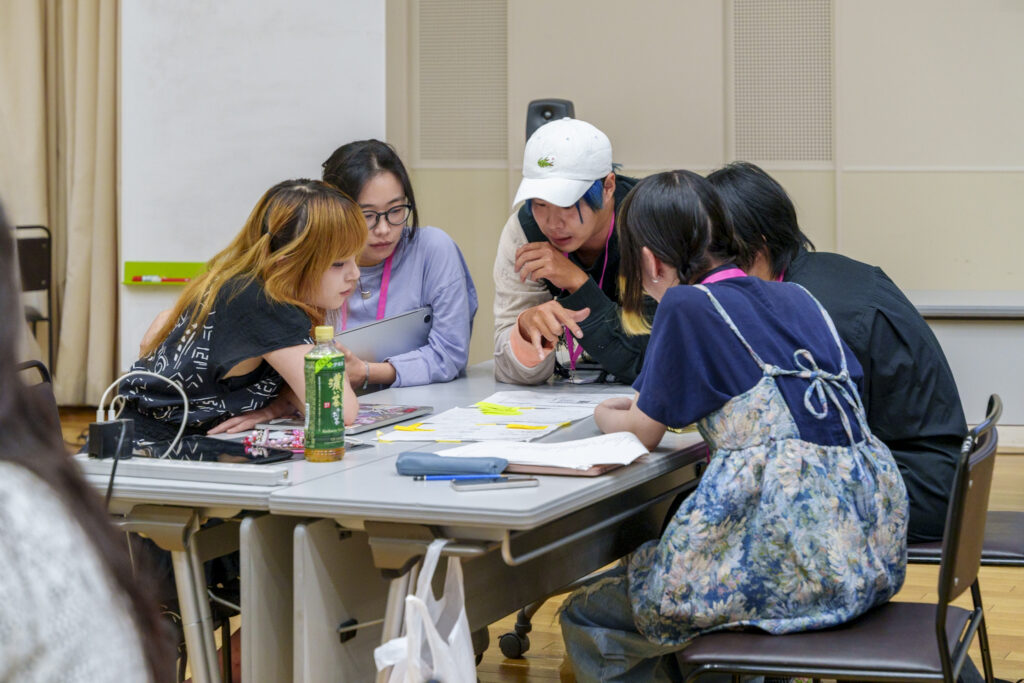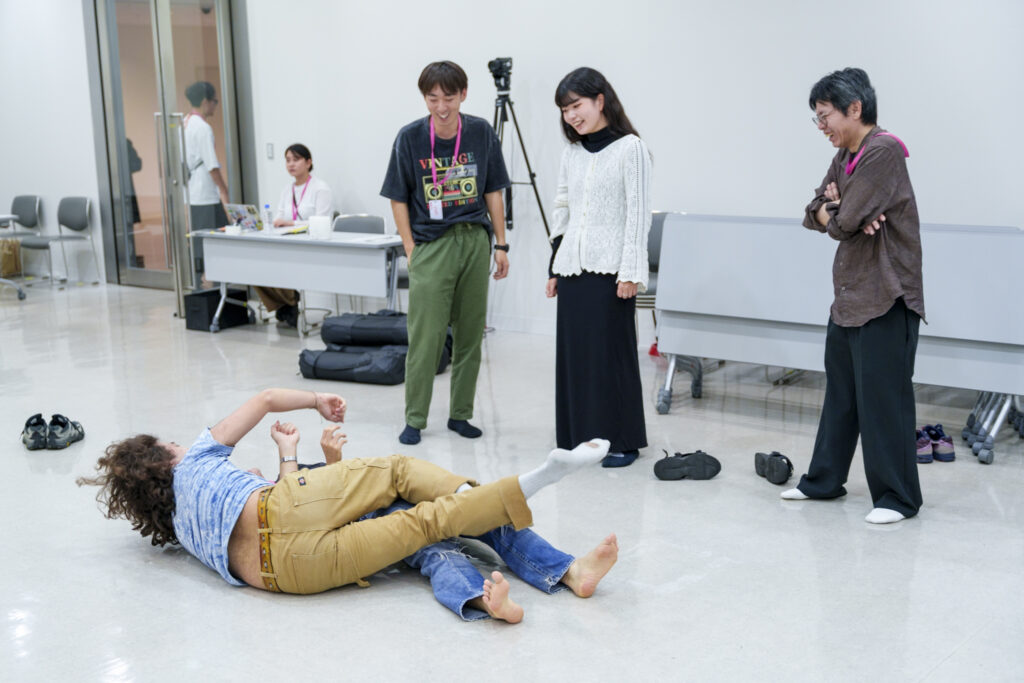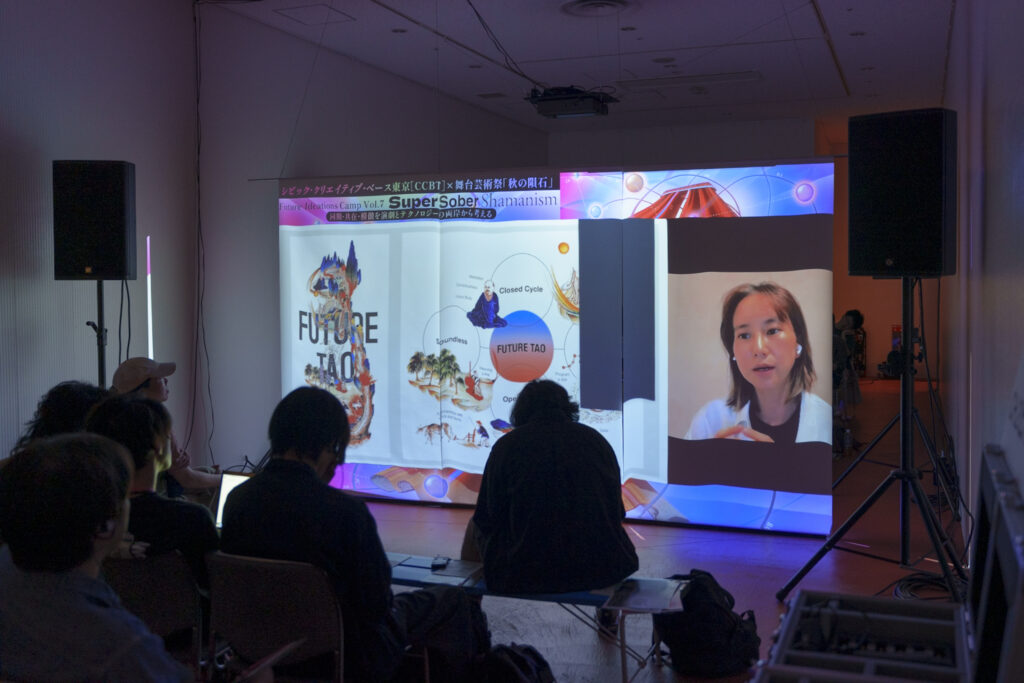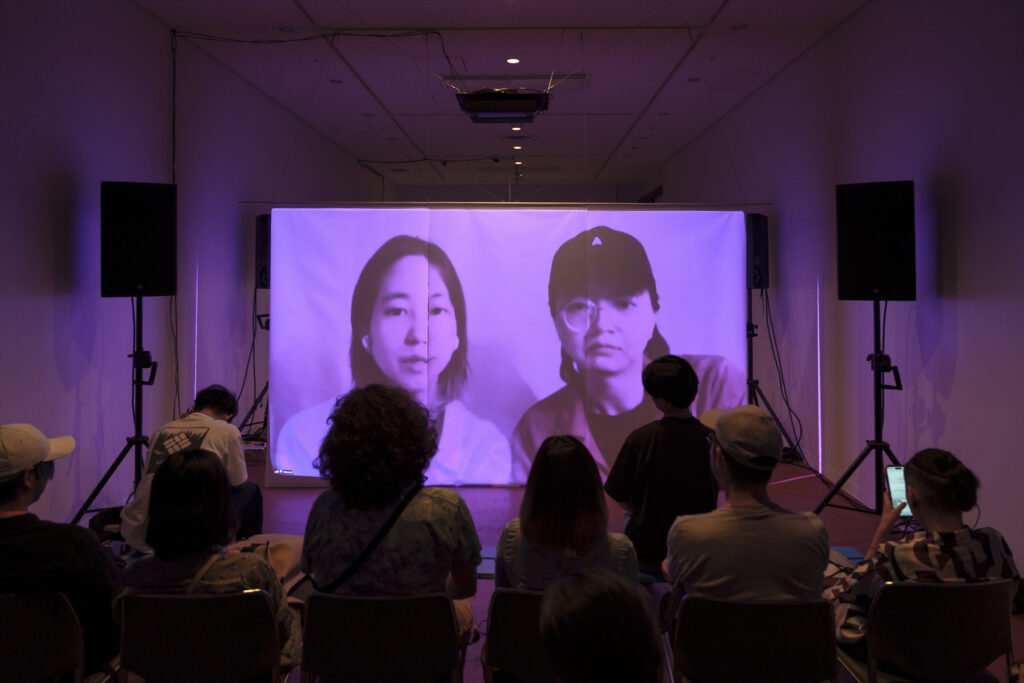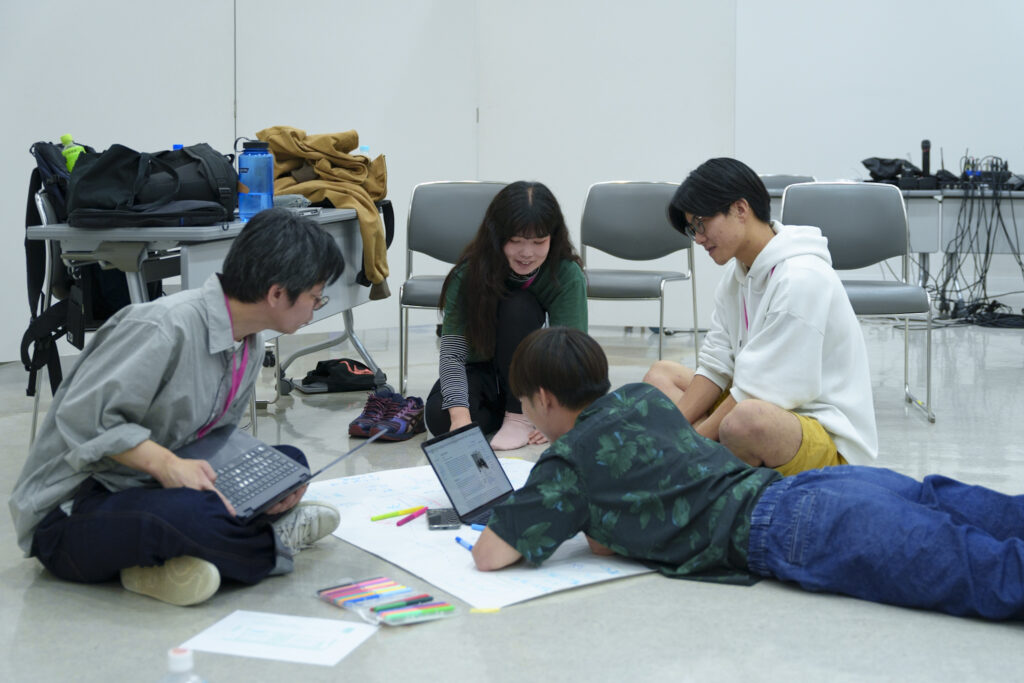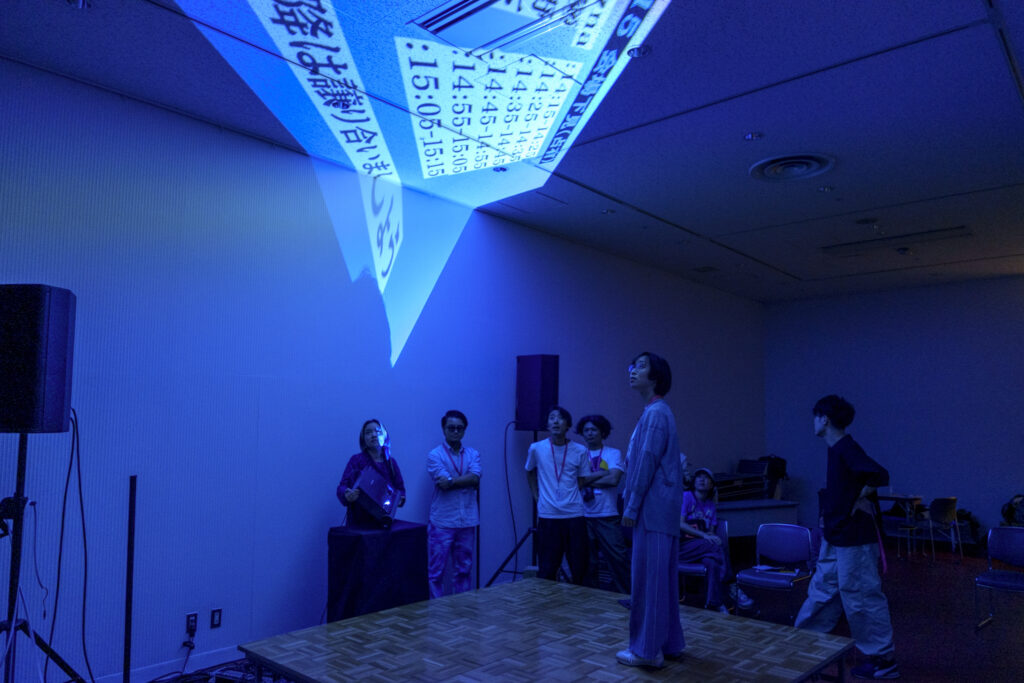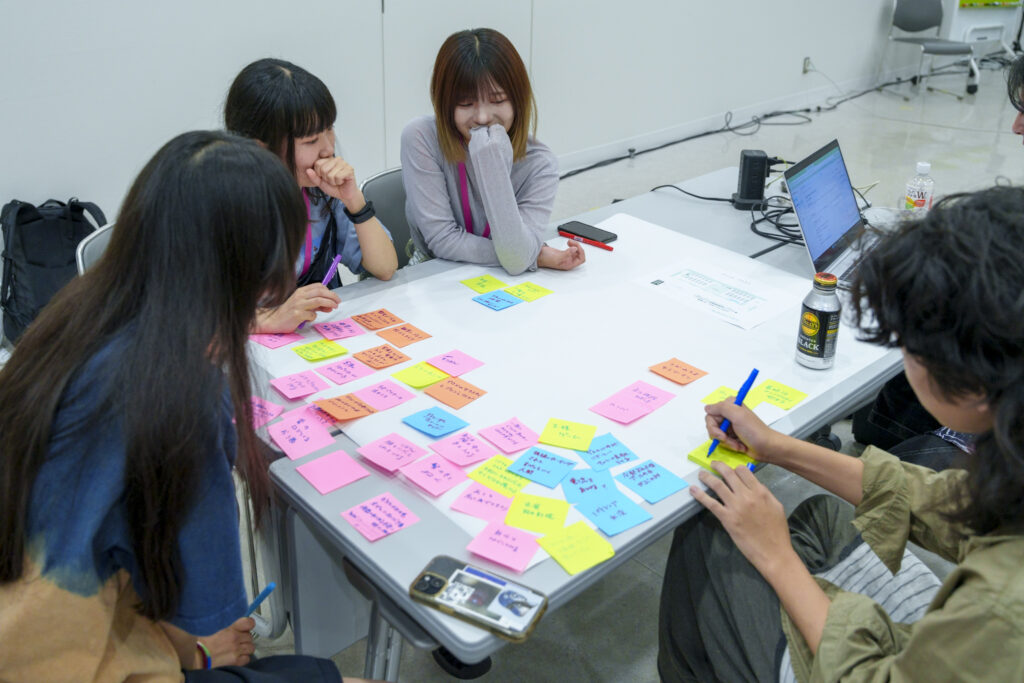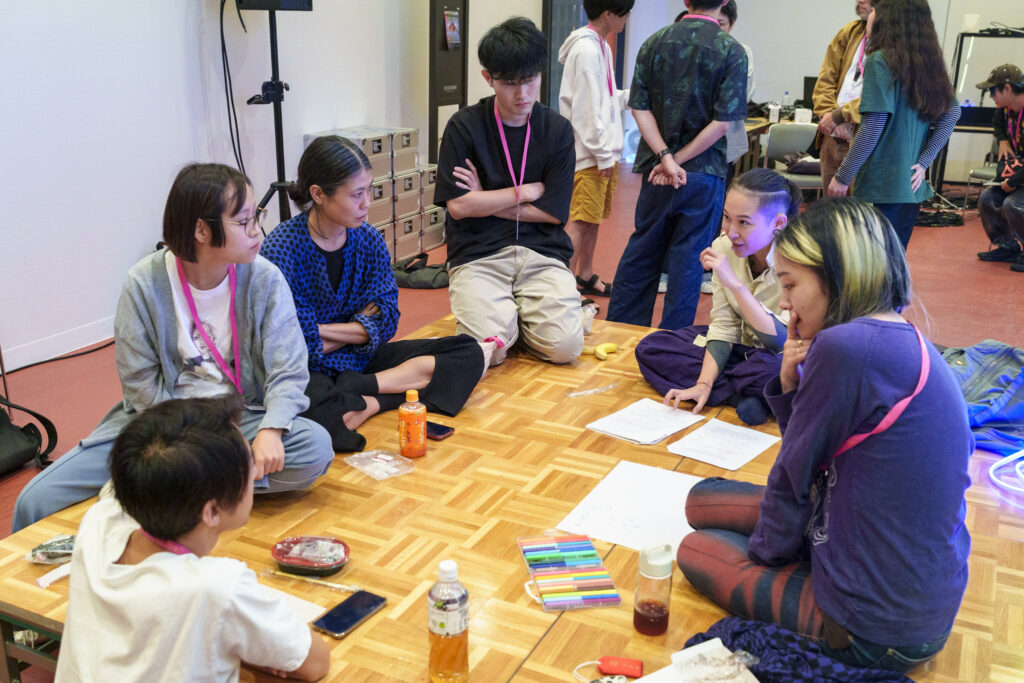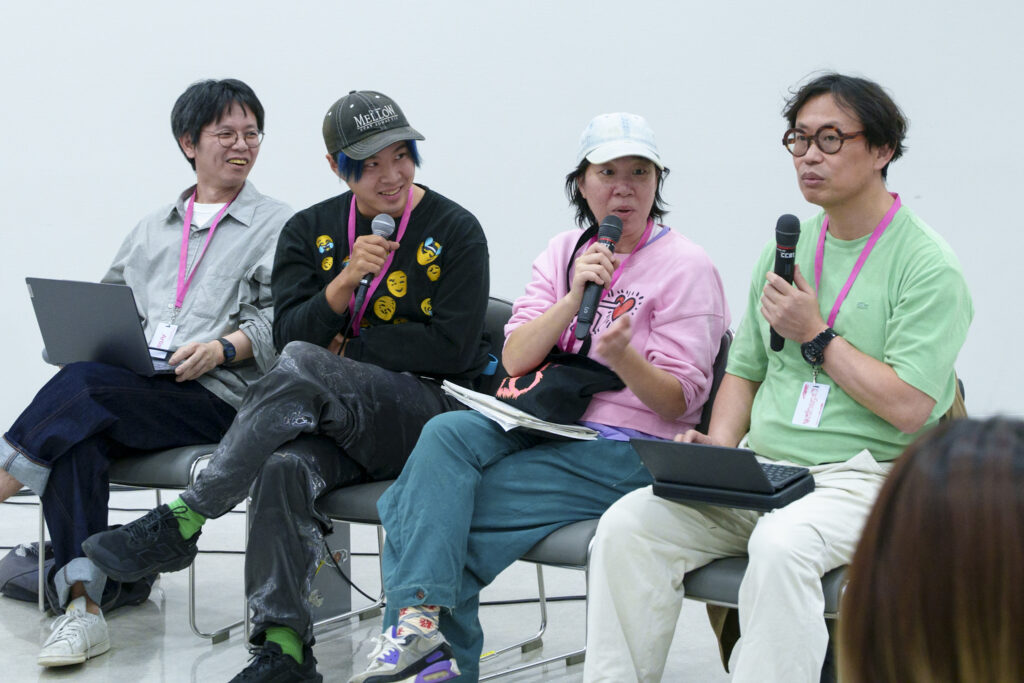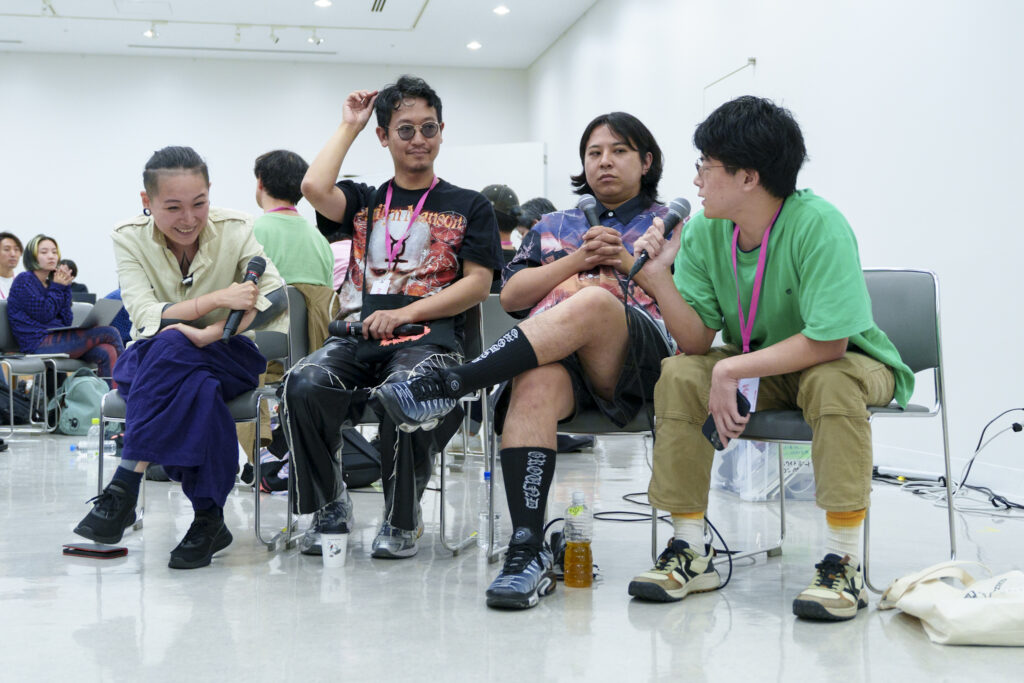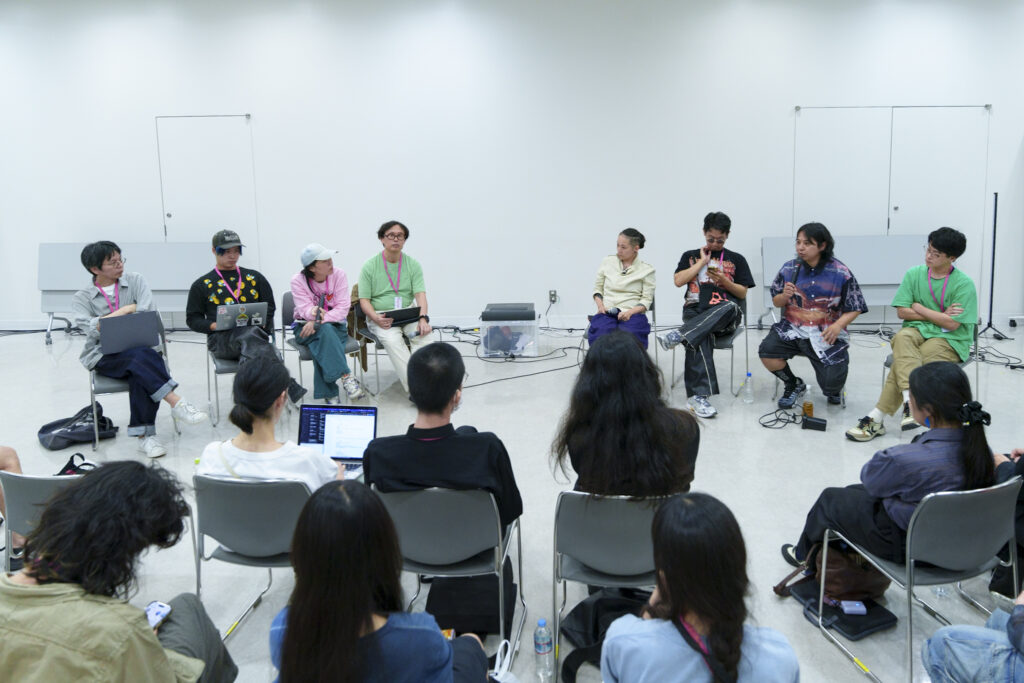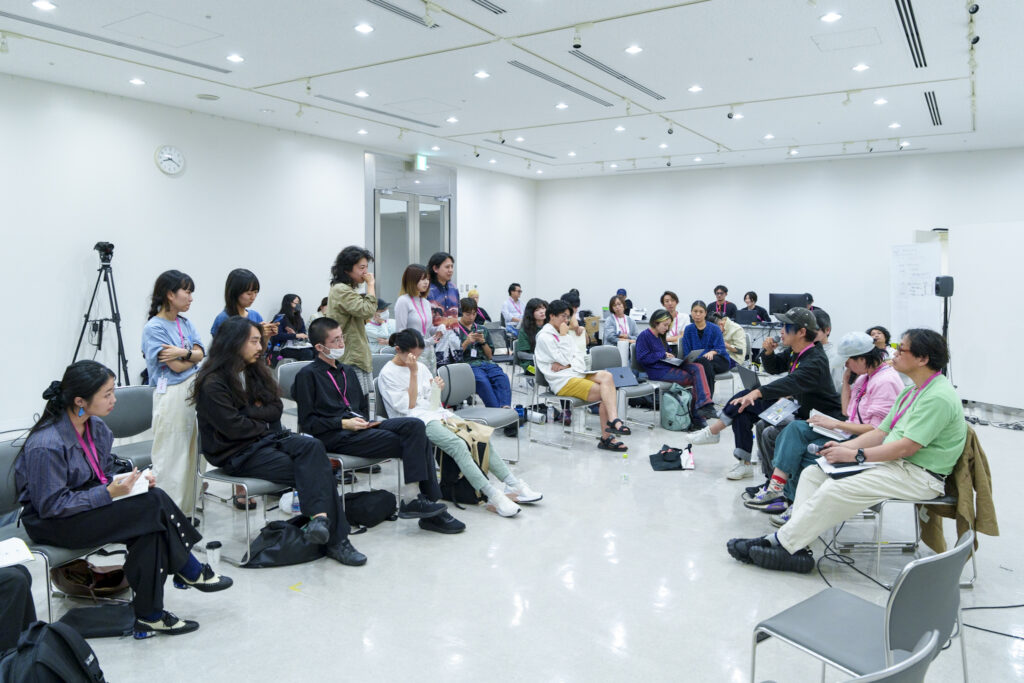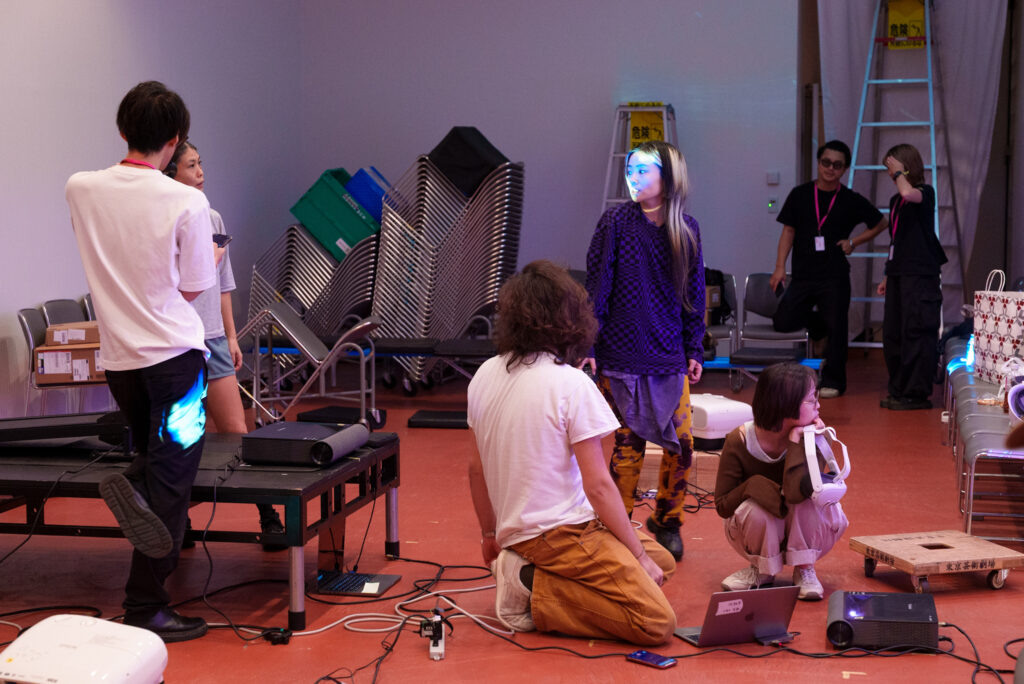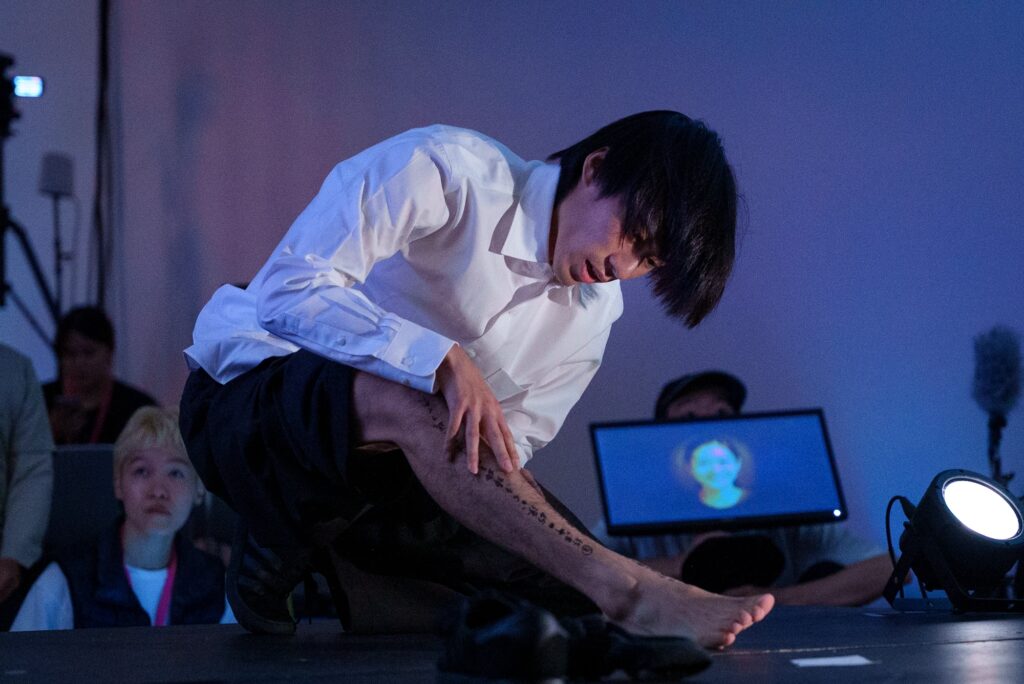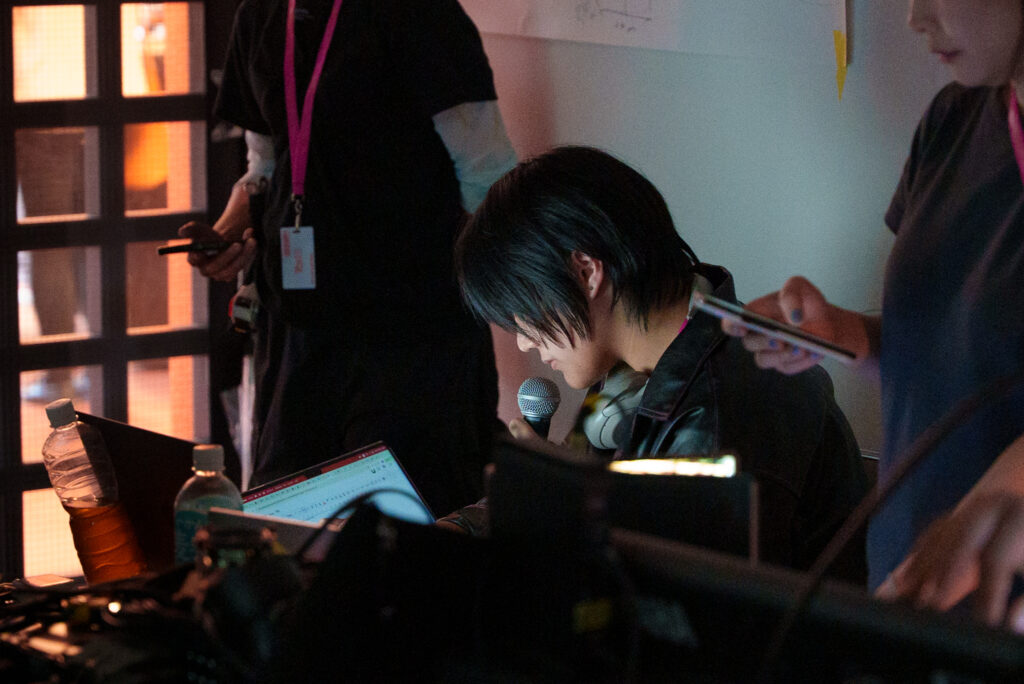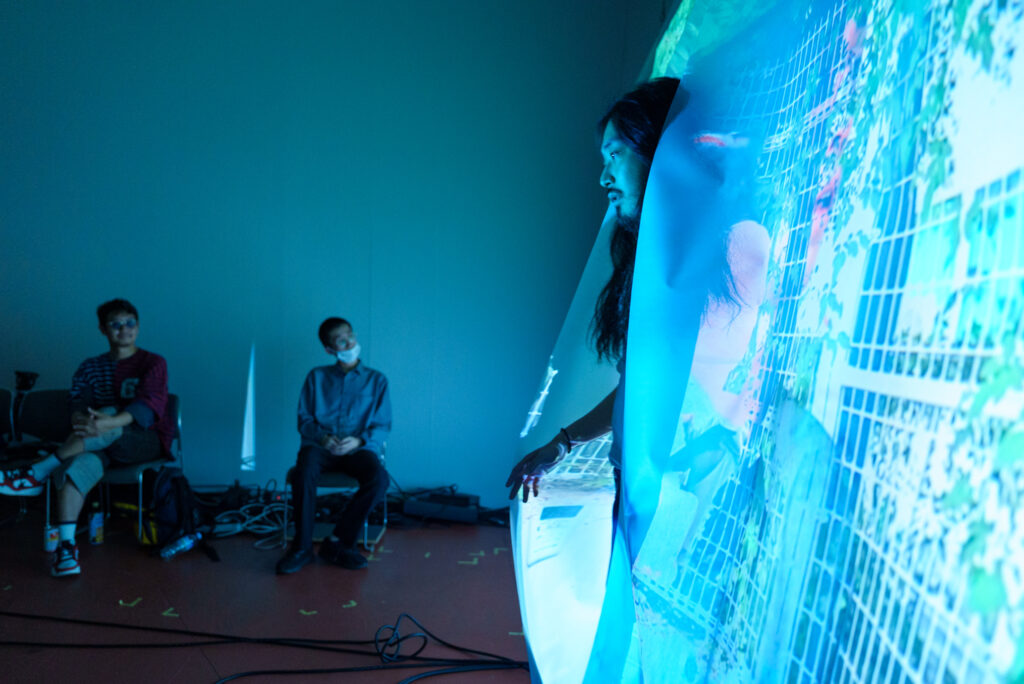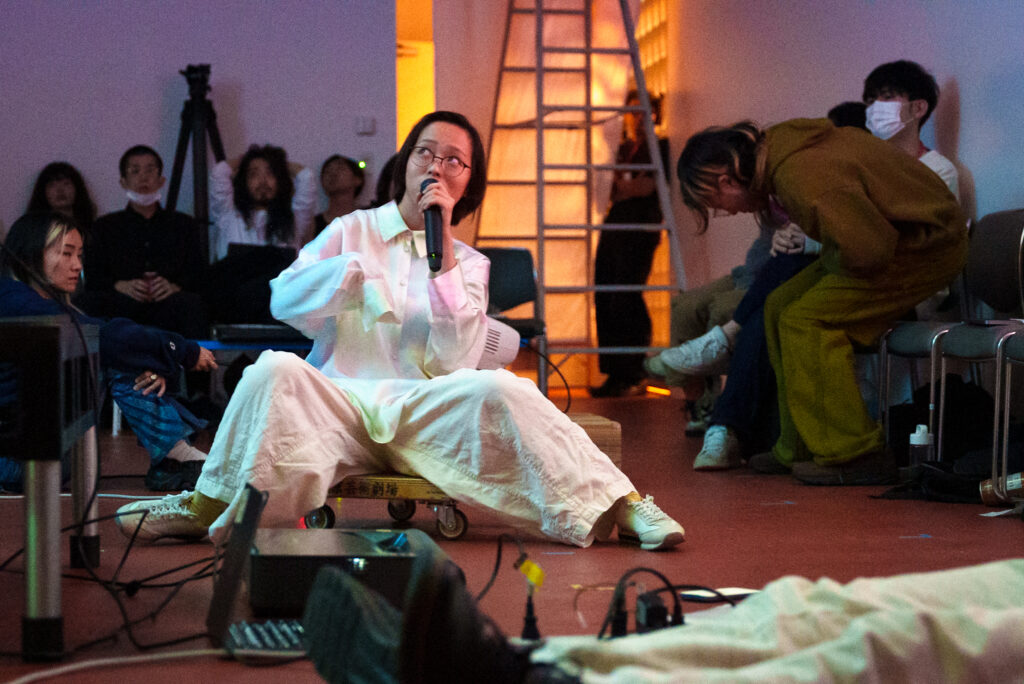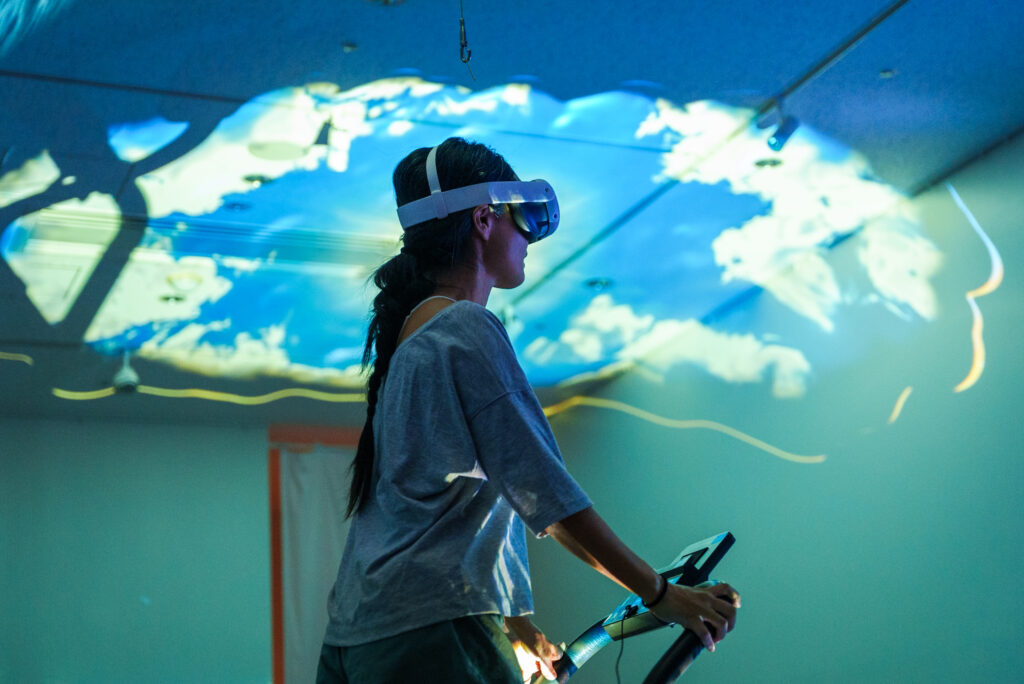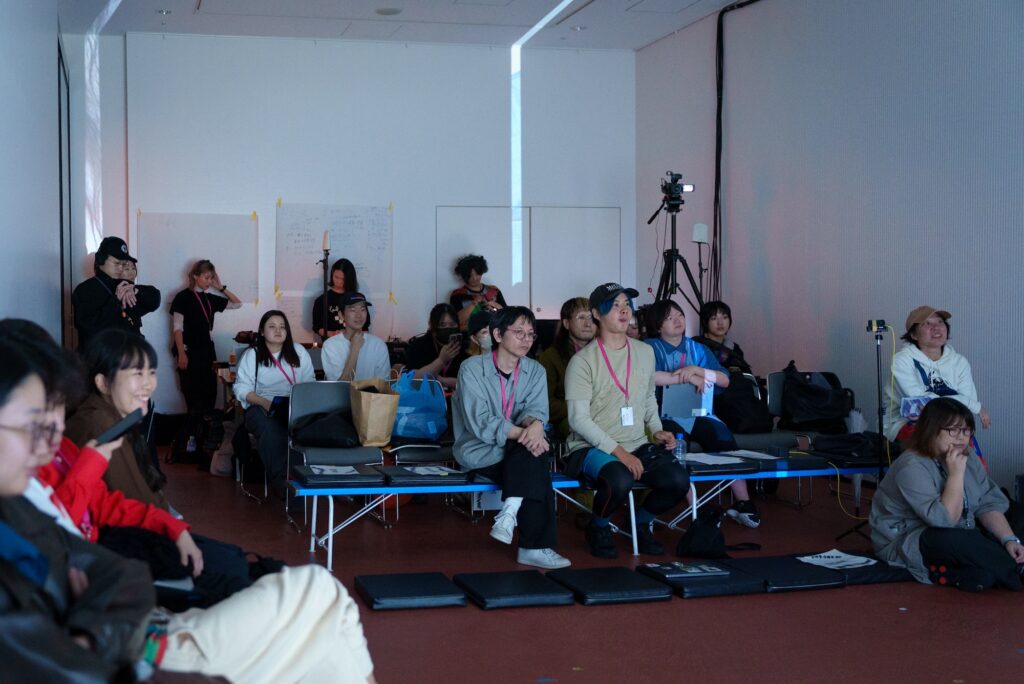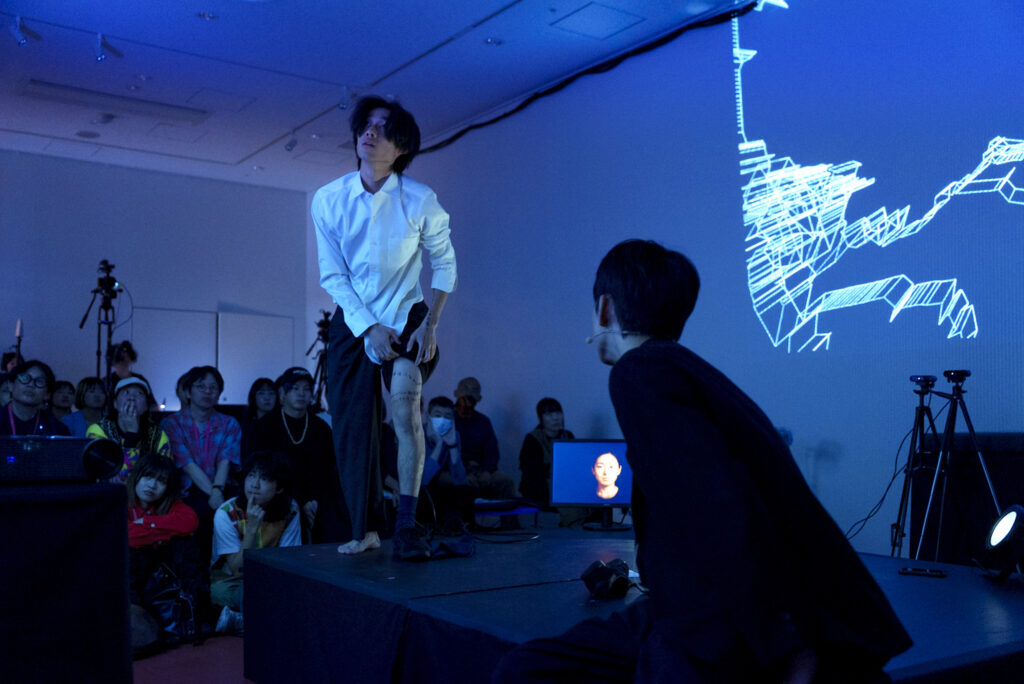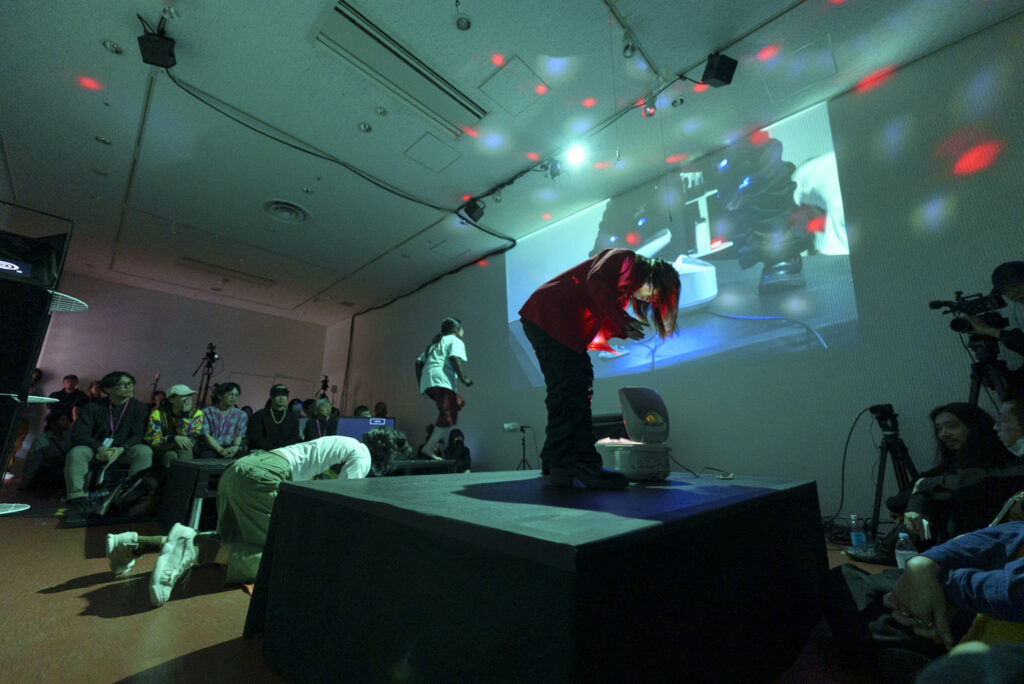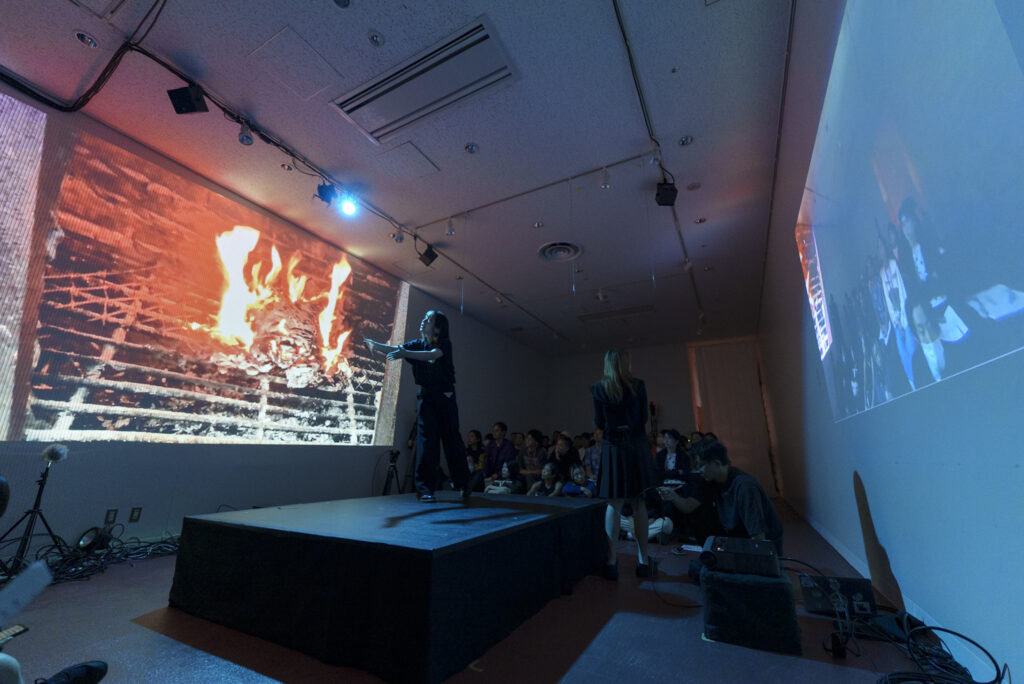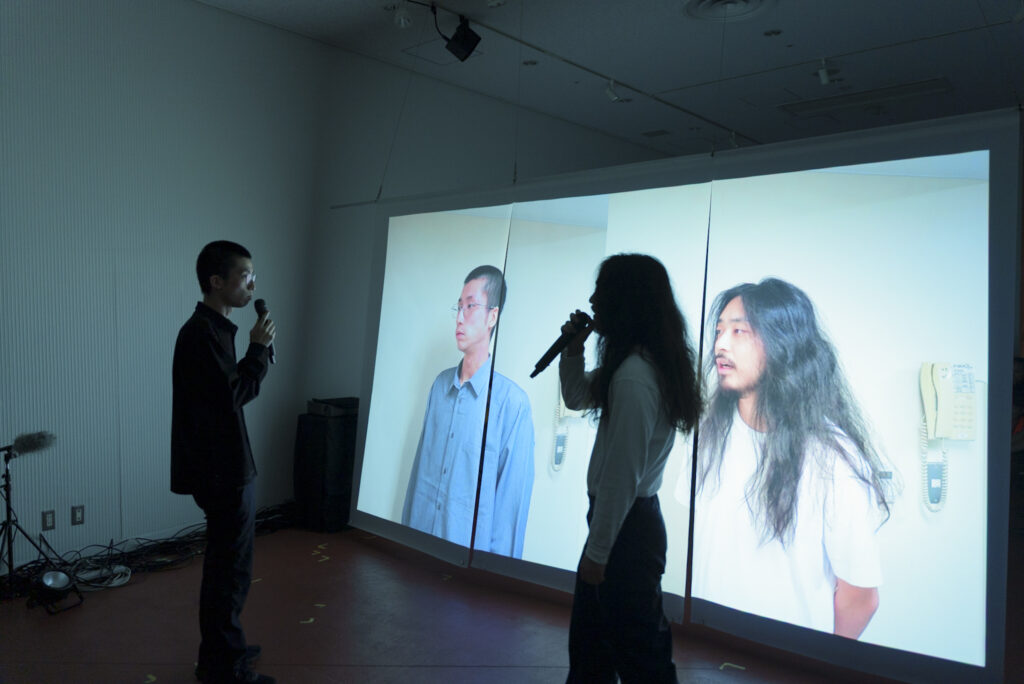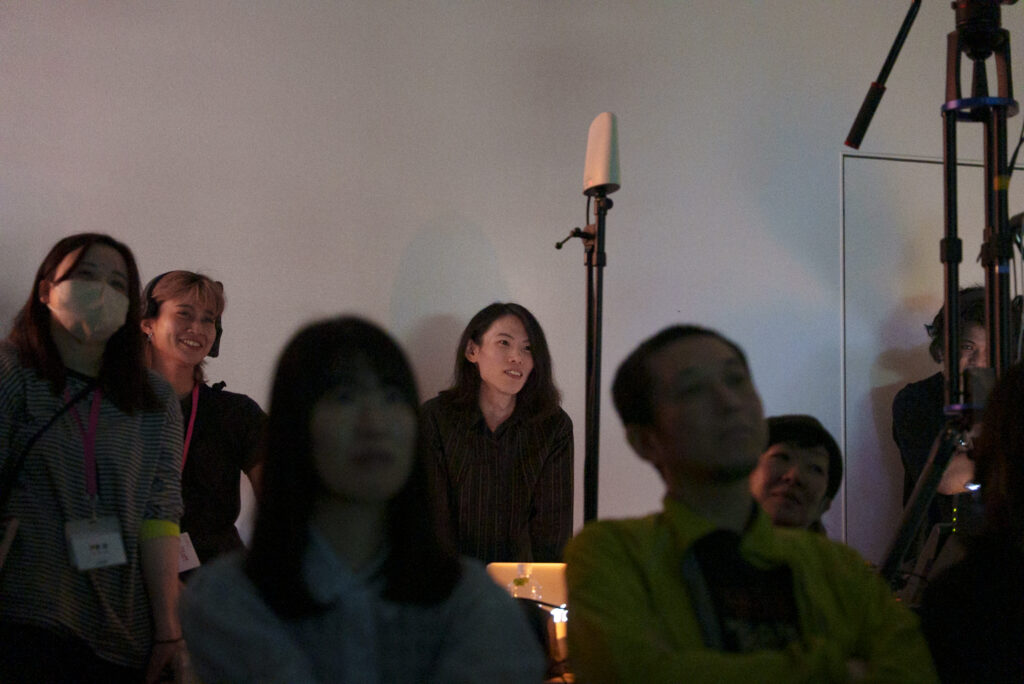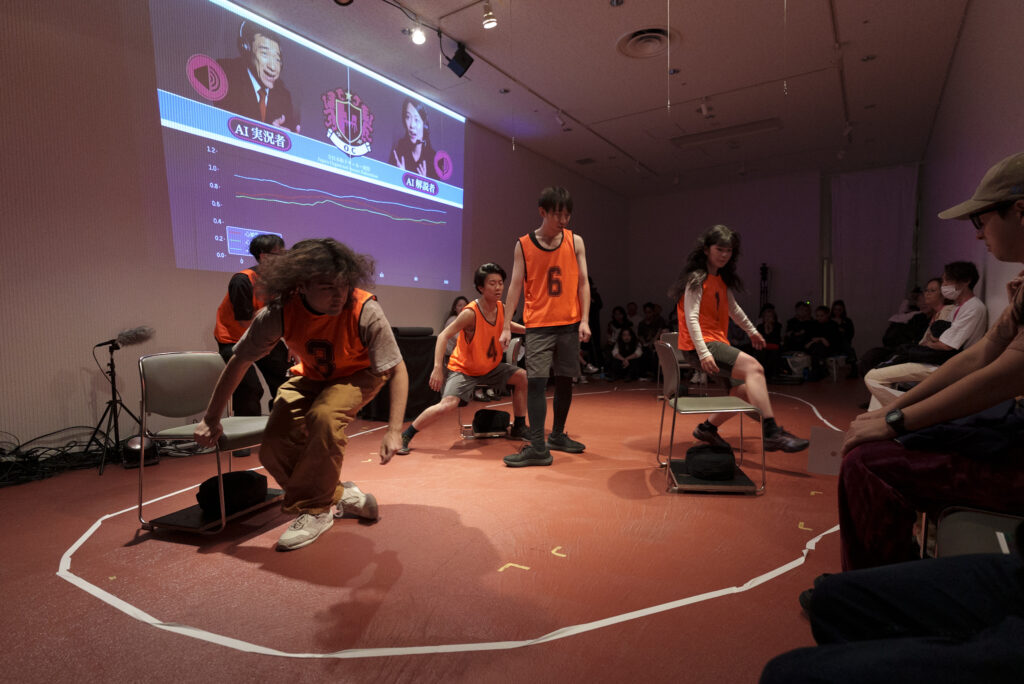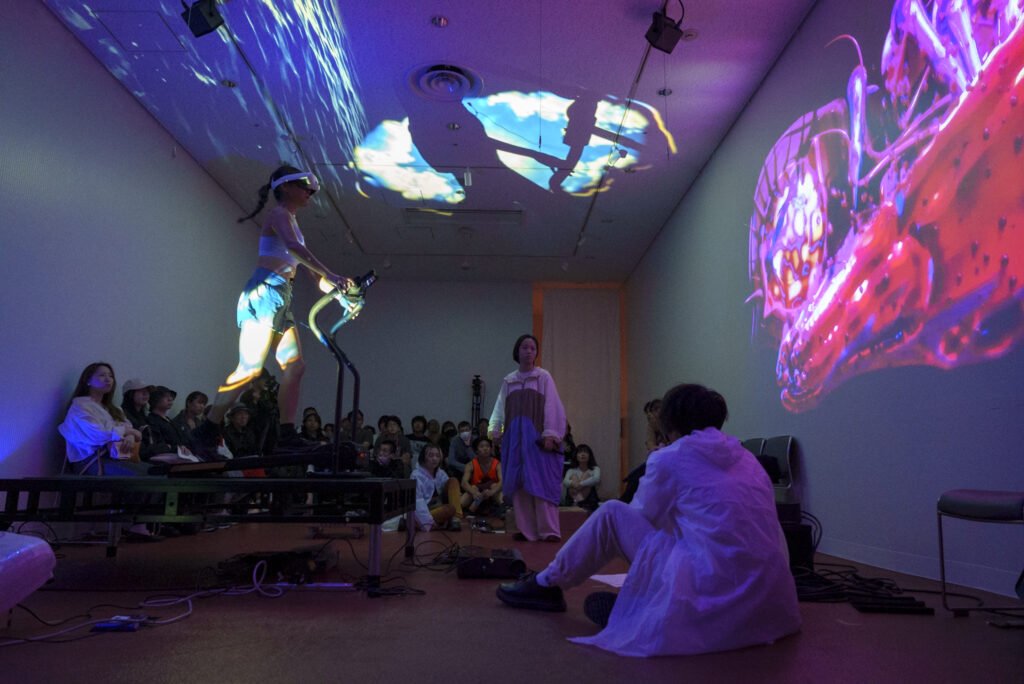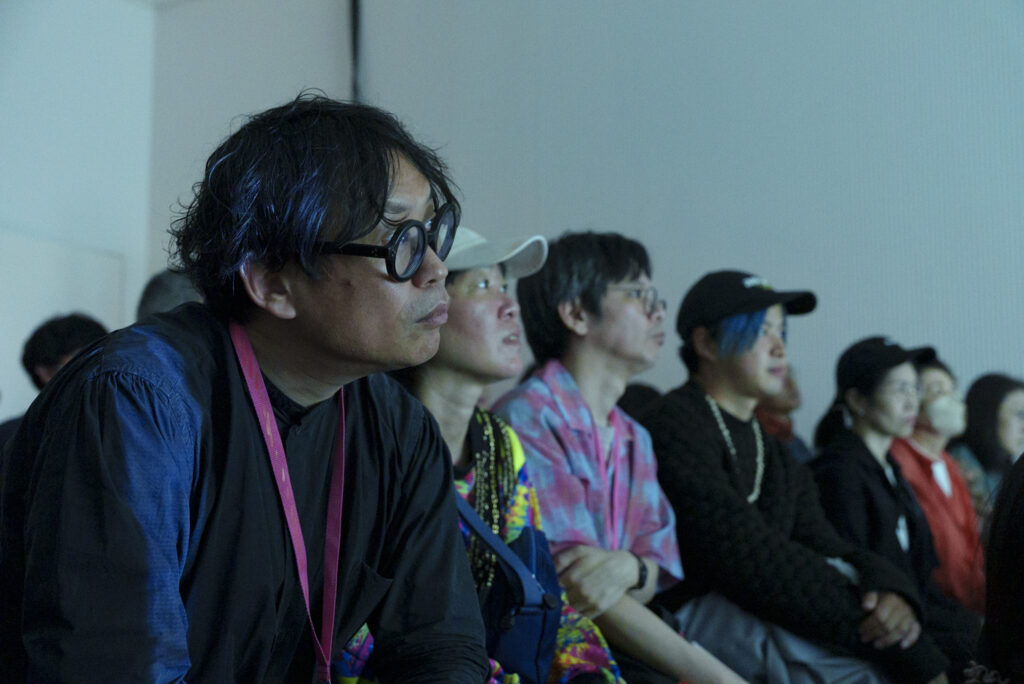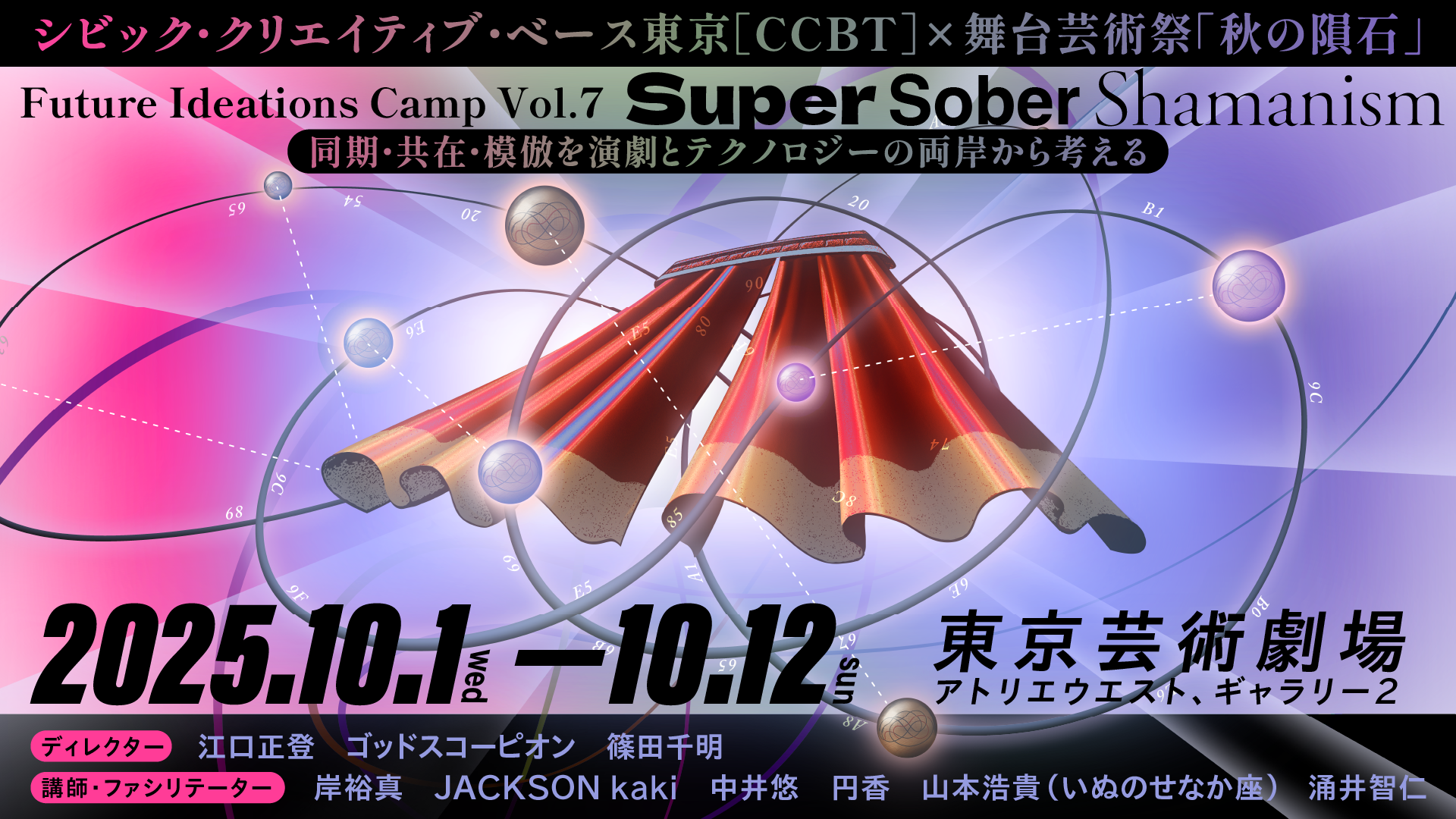
DAY 1
2025.10.1
- Intro: Camp vol. 7 Objective
- Participants’ Self-introductions
- Lecture / Workshop: Staging a Play
Lecturer: Shinada Chiharu (theatre maker and director, after-school instructor, tour guide) - Lecture / Hands-on: A Dialogue with an Alien Intelligence
Lecturer: Kishi Yuma (artist) - Keynote lecture 1: Theo Triantafyllidis: Feral Systems, an Artist Talk by Theo Triantafyllidis
Lecturer (online): Theo Triantafyllidis (artist)
As a joint initiative between CCBT and the Performing Arts Festival: Autumn Meteorite Tokyo, the Camp began with both parties sharing what they each sought to achieve from the collaboration and what they hoped the participants would take home. After one-minute self-introductions by the selected participants, everyone headed to lunch where they could further socialize among a truly diverse group.
Formally kick-starting the Camp was a workshop led by one of the Camp directors, Shinoda Chiharu. She began with an introduction of her artistic practice followed by an exercise based on her 2009 work Anton, Neko, Kuri. Using a customized version of ChatGPT, fine-tuned to generate spoken text and choreographies based on the prompt, the participants practiced their vocals and body work. They then created short performances inspired by curious or uncanny personal experiences. Without a script, the participants learned that they can improvise to create a performance by simply having the mindset to perform and the space in which to stage it.
Next, the lecture and hands-on workshop by Kishi Yuma offered participants to revisit what exactly “AI” can mean. Reflecting on his relationship with “Alien Intelligence” and his creative processes, he encouraged participants to think about AI without falling into mainstream preconceptions. In the hands-on portion of the hour, participants were introduced to a system that generates voices from prompted sound data—entering voices (theirs and others’), whistling, and ambient noise—to experiment what kind of noise can be generated. A notable phrase from the session was, “ by feeding it with private data, you allow the system to become isolated.”
Closing the first day was a keynote lecture by artist Theo Triantafyllidis. He introduced key works in his practices and discussed how he views the relationship between 3D computer-generated environments and architecture, in addition to the performative act of becoming one’s ideal avatar. He also touched on the seamless structure of his practice where in-game items and digital identities can be materialized in physical form in the real world.
DAY 2
2025.10.2
- Lecture: Theatre, Anthropomorphism, Spectatorship
Lecturer: Eguchi Masato (researcher) - Lecture: Front Face Behind (IEIE Backstories)
Lecturer: Nakai You (Side Effects Lab of the University of Tokyo) - Lecture / Hands-on: The Hidden Dimension
Lecturer: God Scorpion (media artist) - Introduction to Plays & Participants’ Discussion
- Keynote lecture 2:The Techne, the Daimon, and the Unknown Superfactor!
Lecturer: Elena Knox (artist, curator, researcher)
The second day began with a lecture by the second of the three Camp directors, Eguchi Masato, who revisited terms such as “theatre” and “performance” and what they can each mean, conceptually, today. Drawing on examples from the history of American performance art, Eguchi organized and contextualized how these concepts have evolved and crossed paths over time.
Nakai You followed with his lecture centered on David Tudor’s 1970s project Island Eye Island Ear. Through archival materials, anecdotes, and even behind-the-scenes of those anecdotes, Nakai offered a new lens for rethinking the notion of “virtual.” Despite it being a lecture, it was highly performative: Nakai spoke wearing a mask of his own face which deliberately blurred the boundary between his identity as the lecturer and performed persona.
The third and final Camp director, God Scorpion, began his lecture and hands-on with a discussion on the conceptual framework of his work. Participants then engaged with AR software, moving swiftly from experimentation to implementation in the cityscape of Ikebukuro, Tokyo.
The subsequent discussion session was designed for the participants to reflect on particular plays chosen by the directors and dramaturgs. These served as a departure point for the participants to be divided into groups and their proposals for a performance. Five plays, including pieces by Kishida Kunio and the Hindu epic Bhagavad Gita, were all cleared of copyright and open for the groups to adapt. After the Camp directors introduced each of the scripts, each participant selected one that stood out to them which was the first step to forming groups.
From the five plays, Gertrude Stein’s I Like It to Be a Play and Cesare Pavese’s Dialogues with Leucò were finally chosen to be further developed and made into adaptations for the final presentation.
Artist Elena Knox’s keynote lecture closed the second day. While introducing her works and projects, Knox elaborated on the lineage of spirits and yokai-like (demon) entities from Greek mythology. Resonating with Eguchi’s lecture from the morning, her talk shared the idea of “personification” as bridging myth, technology, and performance.
DAY 3
2025.10.3
- Facilitators’ Self-introductions
Lecturers: JACKSON kaki (artist, DJ, VJ, video artist, graphic designer), Madoka (modern witch, artist), Wakui Tomohito (visual artist, music artist, Director and Curator / WHITEHOUSE), Yamamoto Hiroki (novelist, designer, critic, editor / director, Inu no Senaka-za) - Time for Hands-on: Touching and Trying out
- Hands-on: Rapid Prototyping
- Presentations of Prototypes
We welcomed the facilitators to the Camp on the third day. After their self-introductions, they presented and demonstrated what they called “peeler technologies”–rudimentary tools or processes connected to their own practices for the participants to experience first hand.
Jackson Kaki’s “peeler” was titled “Toward a Narcissism of 20XX” where participants observed their own movements through an avatar captured in real-time, mobile motion capture technology. Madoka’s peeler, “Rituals, Magic, and Trance for Super Sober Shamanism,” was a guided session where she led participants into a safe state of trance. Yamamoto Hiroki’s peeler titled “A.S.I (Atelier Simulator / Instruction Generator” generated questions from the diary-like everyday entries of the participants and also took prompts that originated from the others’ entries to create new words. Finally, Wakui Tomohito presented “Prepare for Noise with Noise: A Recommendation for Acts of Noise,” a peeler that fused elements of musical performance and activism.
During these hands-on sessions, participants circled each of the facilitators’ stations—what they casually named “peeler islands”—to experiment with and experience the different peelers. The participants then began to rapid-prototype their ideas combining elements learned from the sessions. Through this process of rapid prototyping, participants explored how practices and tools can be synthesized into new performative experiments, which they then each presented to conclude the day.
DAY 4
2025.10.4
- Participants’ Proposals
- Directors & Facilitators Feedback / Approved Proposals
- Group Work: Brainstorming
- Keynote lecture 3: The Techne, the Daimon, and the Unknown Superfactor!
Lecturer: Elena Knox (artist, curator, researcher)
Now at the Camp’s halfway point, participants entered the phase of group work in preparation for their performances for the final presentation. The participants first proposed the projects they had been developing, after which they each voted for the ones they wanted to see performed. The proposals that received the most votes were then further developed, and another round of votes—this time for ones they wanted to join—deteremined the six groups and final projects that were to be performed.
Now in groups, they brainstormed how best to present their pieces at the final presentation. God Scorpion and Eguchi Masato joined the four facilitators; they each guided a group to further develop and materialize their ideas for their performance.
The final keynote of the Camp was by the artist duo, lololol titled “Choreography of Collapse.” Sheryl Cheung introduced lololol’s practices and works with a special emphasis on 3C Xing Yu Quan and Fractal Memory. For this talk, a projector screen divided the room in half with audiences on both sides of the screen. Xin Lin joined the Q&A to demonstrate how their practice draws from Taoist thinking and how they (re)interpret the ever-shifting cosmological diagrams as scores for their practice.
DAY 5
2025.10.5
- Group Work
- Presenting Proposals & Reflecting Feedback
Guest: Okada Toshiki (Artistic Director of Performing Arts Festival: Autumn Meteorite Tokyo)
The group continued to work on their performances as the facilitators and directors made rounds, providing guidance and suggestions as necessary. For them, it was a chance to see the other groups and for the groups it was an opportunity to receive more feedback from other facilitators to better their ideas.
For the proposal presentations, we welcomed Okada Toshiki, the Artistic Director for Performing Arts Festival: Autumn Meteorite 2025 Tokyo. Following each group’s presentations, Okada offered his comments and feedback together with the Camp directors and facilitators. This helped identify the key concern that seemed to run through the groups, participants, and Camp as a whole: the requestioning of theatre as a performance as well as a space.
The feedback seemed to make the groups nervous and excited as they further developed their performances.
DAY 6-8
2025.10.7-9
- Creation
During the creation period, each group continued to work on their projects towards their final presentations exploring new approaches in “theatre” incorporating technologies picked up throughout the Camp. Building on the feedback from the day prior, participants engaged in heated discussions in each of their groups to refine their approaches and consulted closely with the facilitators, technical team, and stage manager as they gradually brought their ideas to life.
DAY 9
2025.10.10
- Creation
- Run-through
As the creation progressed, the groups were provided with time to do run-through rehearsals. Each group worked on their stage directions, continuing to work with the facilitators and directors, to further refine and shape their performances.
DAY 10
2025.10.11
- Creation
- Dress rehearsal
We had a dress rehearsal on the final day of the creation period for the groups to finalize their performances. All technical elements such as lighting, sound, and video were incorporated as the group rehearsed from beginning to end. Under the conditions of the final presentations, the groups were able to make final adjustments, a final tweak before they performed in front of a live audience the following day.
DAY 11
2025.10.12
- Final preparation
- Final presentation
The final day of the Camp; the day of the final presentation. Each group performed their “theatrical” piece, now, in front of a public audience, sharing their experimentations and insights from the intense 5-days with their fellow participants and the public. Following their performances, Okada Toshiki and the Camp directors gathered to offer their reflections, bringing the 11-day Camp to a close.
Photo by Shunsuke Watanabe


